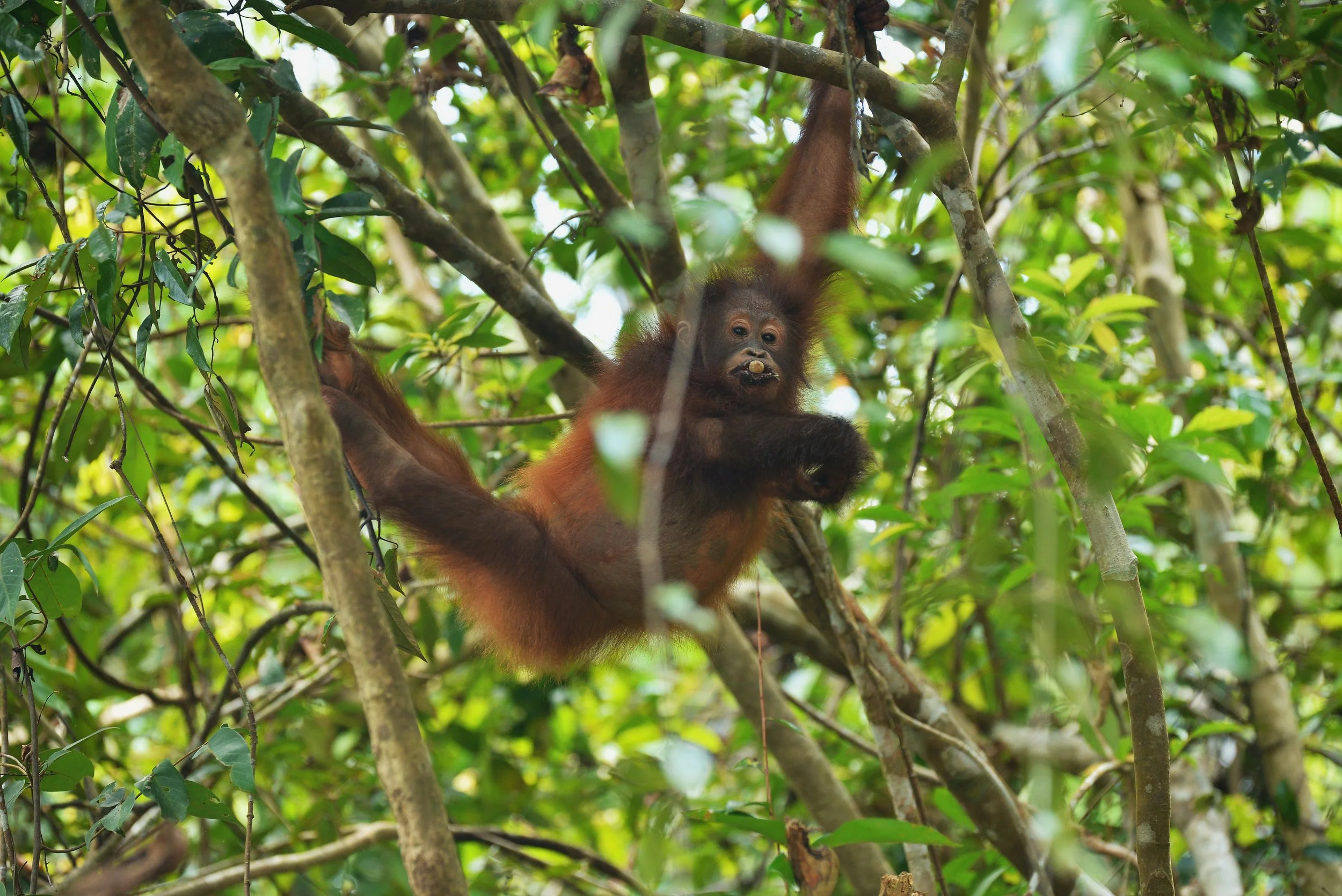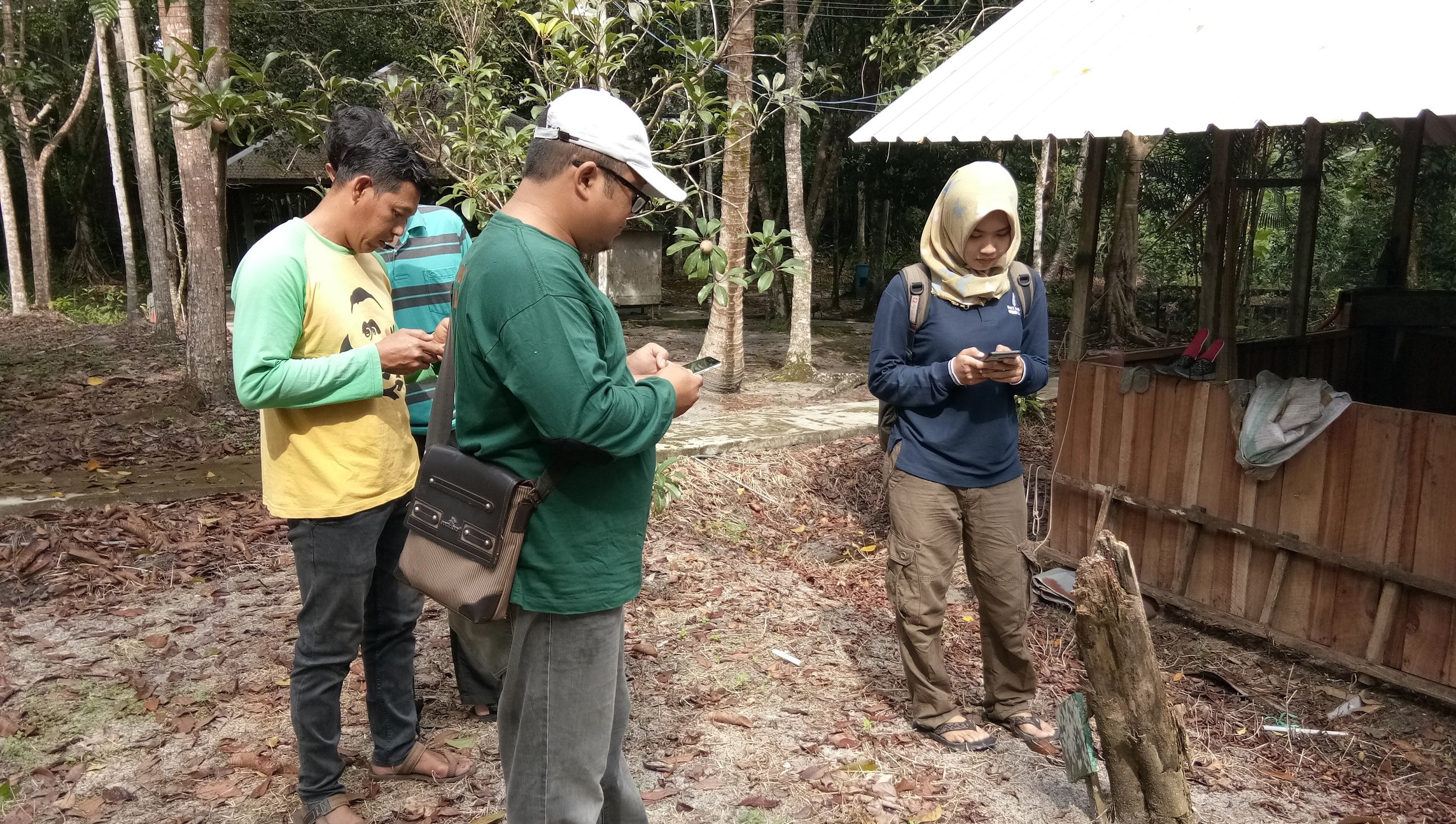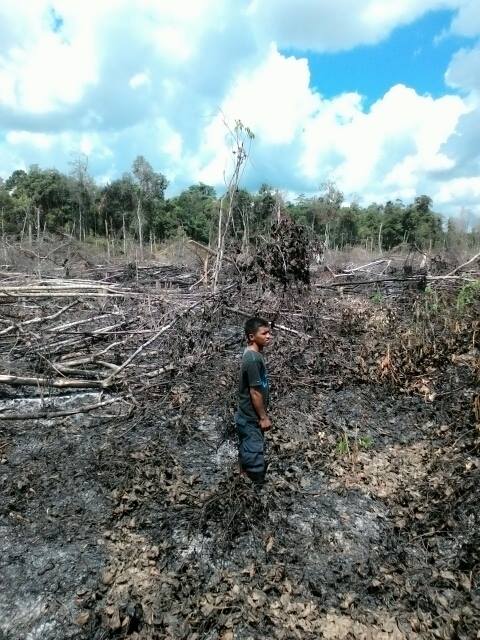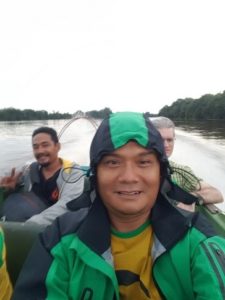Orangutans consume a variety of food from the forest to support their large size. Being arboreal species gives them access to the food they need to sustain their body size.
Young orangutan rescued
Yesterday, we rescued a young orangutan, aged approximately 5-years-old. Sadly, the mother was absent, we don’t know what happened to her but most likely she has died, mother orangutans would not readily abandon their offspring.
Tranquillised orangutan, named Panglima
The Wildlife Rescue Unit (WRU) team was made up of the Central Kalimantan Wildlife Department (BKSDA) and Orangutan Foundation. The Wildlife Department had received reports about an orangutan seen in a community orchard. The rescue team drove 45 minutes from the town of Pangkalan Bun to the reported location in the Pangkalan Lima area, South Arut District.
Orangutan nest high up in the tree
When the team arrived they saw two nests in one tree, but there was no sign of an orangutan. After a while the team decided to return to Pangkalan Bun. In the afternoon, the team received another report about the orangutan and so they returned. This time they saw a young orangutan very high up in the trees. The team decided to follow the orangutan until it nested in hope they could get a clear shot with the dart gun. Unfortunately they couldn’t and because it was getting dark and unsafe they decided to return very early the next morning, when hopefully the orangutan would still be in his nest.
Preparing the dart gun to tranquillise the young orangutan
Climbing up the tree to rescue the sedated wild orangutan.
The next morning, in the torrential rain, the rescue team arrived at the nest location at 4.30am. The orangutan was found above a nest, not far from where they had left him. The dart gun was prepared so that the orangutan could be tranquillised. They managed to get a clear shot and the orangutan fell into its nest. One of the rescue team climbed a 10-meter tall tree and managed to carry the orangutan down.
The Orangutan Foundation vet immediately conducted an examination and the orangutan was male, weighing approximately 15kg and was estimated at around 5-years-old. Our vet, Dr. Dimas Yufrizar, took blood samples for laboratory tests and gave injections of multivitamins and antibiotics.
The orangutan has been named Panglima (relating to the rescue location) - giving orangutans names helps the field staff with post-release monitoring and communications.
Tranquillised orangutan being examined by Orangutan Foundation vet
Panglima was transported to the Pangkalan Bun BKSDA SKW II office where he is being kept temporarily in a holding cage. Hendra Gunawan, Orangutan Foundation Program Manager said BKSDA have requested that the orangutan be translocated to the Lamandau Wildlife Reserve, a protected area. Before release, Hendra said Panglima will be isolated until his blood tests return and then habituated for three months. His condition will be monitored by the Orangutan Foundation vet and field staff.
The rescue team are confident that Panglima’s release into the reserve will be successful and that he will go on to live a wild and safe life in the Lamandau Wildlife Reserve.
Support our work and join Orangutan Foundation today.
Conservation of wild orangutans living outside protected areas
A very successful two day workshop was organised by our partners Yayorin (Indonesian NGO) and Orangutan Foundation to address the conservation issues facing 78% of wild orangutans, who live outside of protected areas. The focus was training in SMART technology to monitor and survey orangutan populations and prevent crimes against orangutans, wildlife and forests.
Certificate awarded for participating in SMART training
The workshop was well attended and all participating received practical training.
Workshop attendees included Yayorin, Orangutan Foundation, SKW II Balai KSDA Kalimantan Tengah, Tanjung Puting National Park Office, Sukamara-Lamandau Regional Forest Service Office (KPHP) , Seruyan Regional Forestry Service Office (KPHP), Nangamatu Village - Belantikan Raya and Pangkalan Bun Antakusuma University.
Thank you to Arcus Great Apes and Gibbon Program for funding this important initiative.
Wild orangutan rescued and moved to safety
When our staff arrived at the oil-palm plantation they found the orangutan in an area of forest, on the riverbank of the plantation. We had been called in to help by BKSDA SKW II Pangkalan Bun (government agency for wildlife) who had received reports from an oil-palm plantation of an orangutan in their plantation. It was decided to capture the orangutan and move her to the protected Lamandau Wildlife Reserve, to avoid potential conflict.
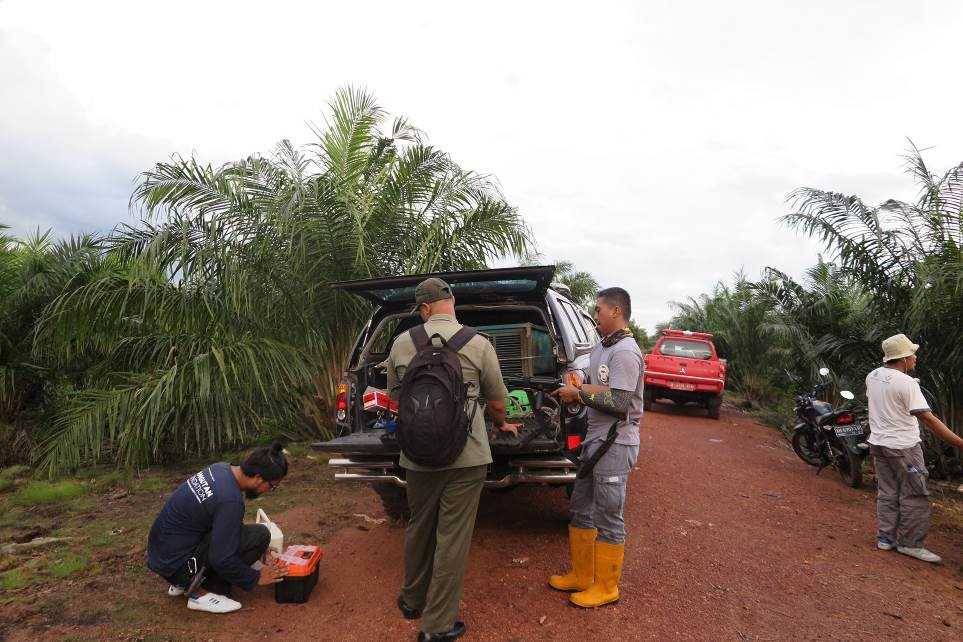
The orangutan, who they identified as female, had made and was resting in a nest. This made it easier to dart her as she wasn’t moving.
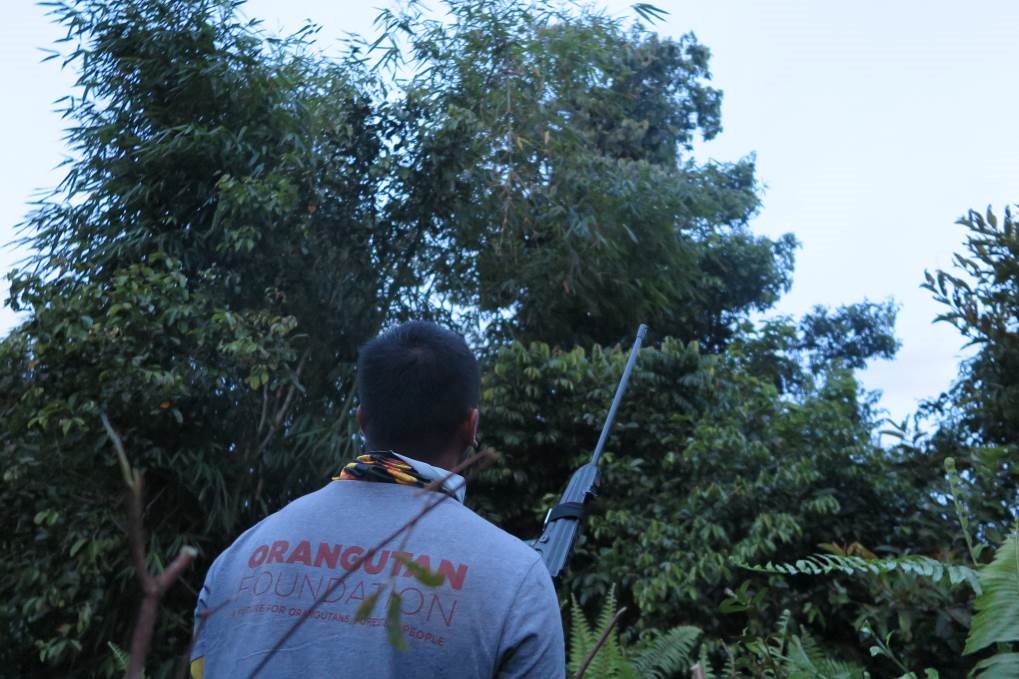
What our staff hadn’t anticipated was that she might just remain where she was and fall asleep, making it very difficult to then rescue her. This is just what happened!
One of our rescue team staff, Mr Nasibah, also an expert tree climber, shinnied up the tree to the nest. With huge effort he managed to lower the unconscious orangutan out of her nest. Our staff on the ground, used netting to catch her, as she fell to the ground.
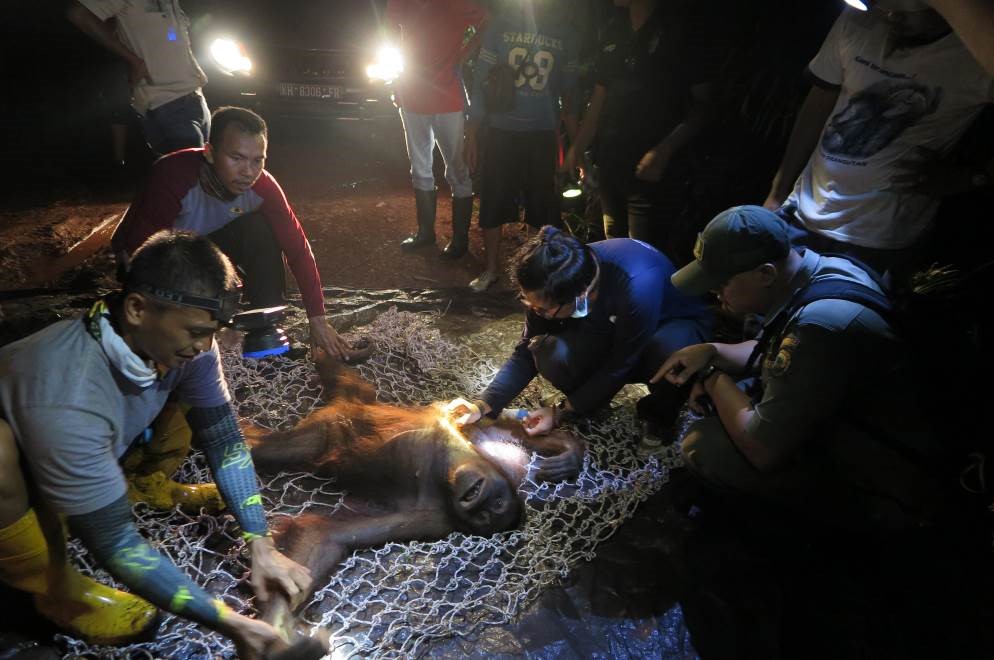
She was quickly transported to an open area where our vet Dr Dimas, examined her. Apart from a small scratch to her chest, she was in full health, weighing 45 kilos and was thought to be around 18 years-old. The scratch was cleaned and injected with long-acting antibiotics to prevent infection.
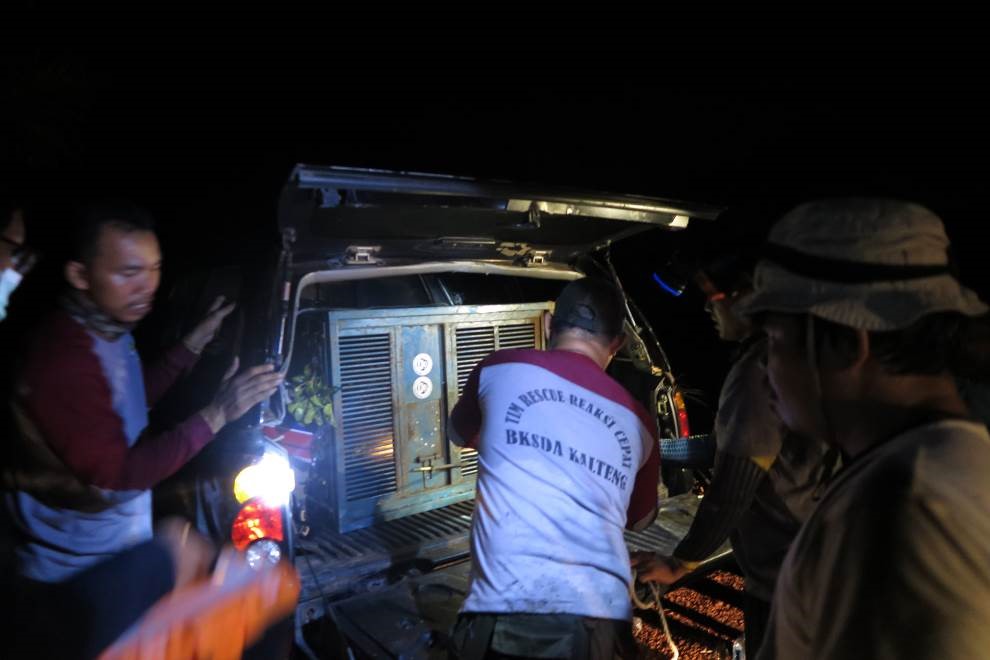
Two days later the orangutan was released in the Lamandau Widlife Reserve, on the opposite side of the river from Camp JL. We protect this forest reserve with guard posts and regular forest patrols to prevent and deter illegal activities.

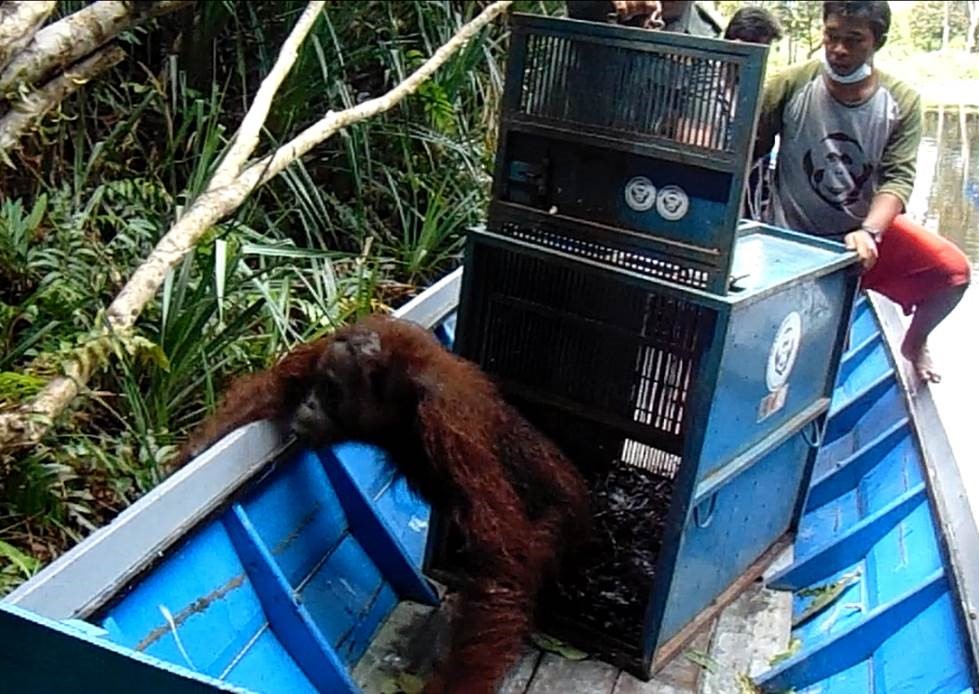
As soon as the transport cage door was opened she actively climbed into the nearby trees and disappeared into the forest.This, we hope, is her last encounter with humans.

The Lamandau Wildlife Reserve totals 158,144 acres of tropical forest and is home to a population of more than 500 orangutans. Half of these were reintroduced or translocated and given a second chance of survival in the wild. We must make sure they are stay safe. Please donate to our urgent appeal – DONATE TODAY
Vet's first orangutan rescue
The Orangutan Foundation is delighted to welcome Dimas Yuzrifar as its new vet, replacing Dr Steven, who has now returned to Bali. Being "thrown in at the deep end" is certainly how the first week has been for Dr Dimas! Last weekend we received reports of a wild orangutan in village forest. This was passed onto the government agency for wildlife, BKSDA SKW II Pangkalan Bun.
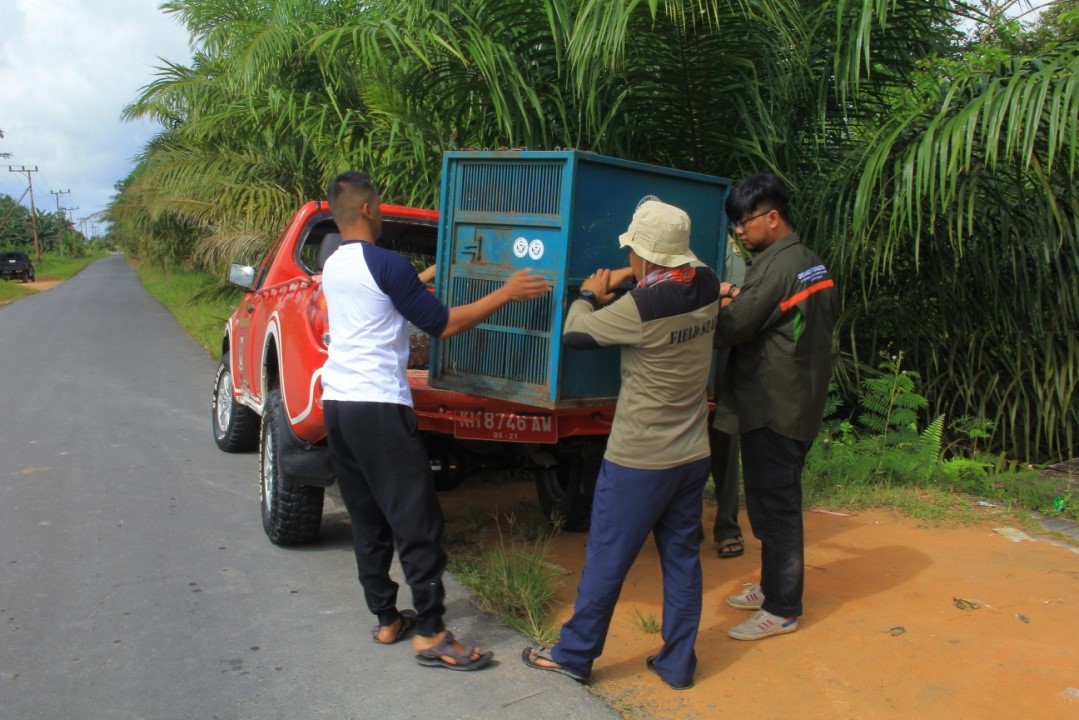
The orangutan was found close to oil palm, banana and rubber plantations owned by local residents. The villagers feared the orangutan would damage their crops and so BKSDA decided, in this case, to capture and move (translocate) the orangutan, to avoid any conflict arising. Dr Dimas managed to anesthetize the orangutan. After being caught the orangutan was identified as female with an estimated weight of around 25 kg. The next day after checking the orangutan was well and active she was released into the safety of the protected Lamandau Willdife Reserve.
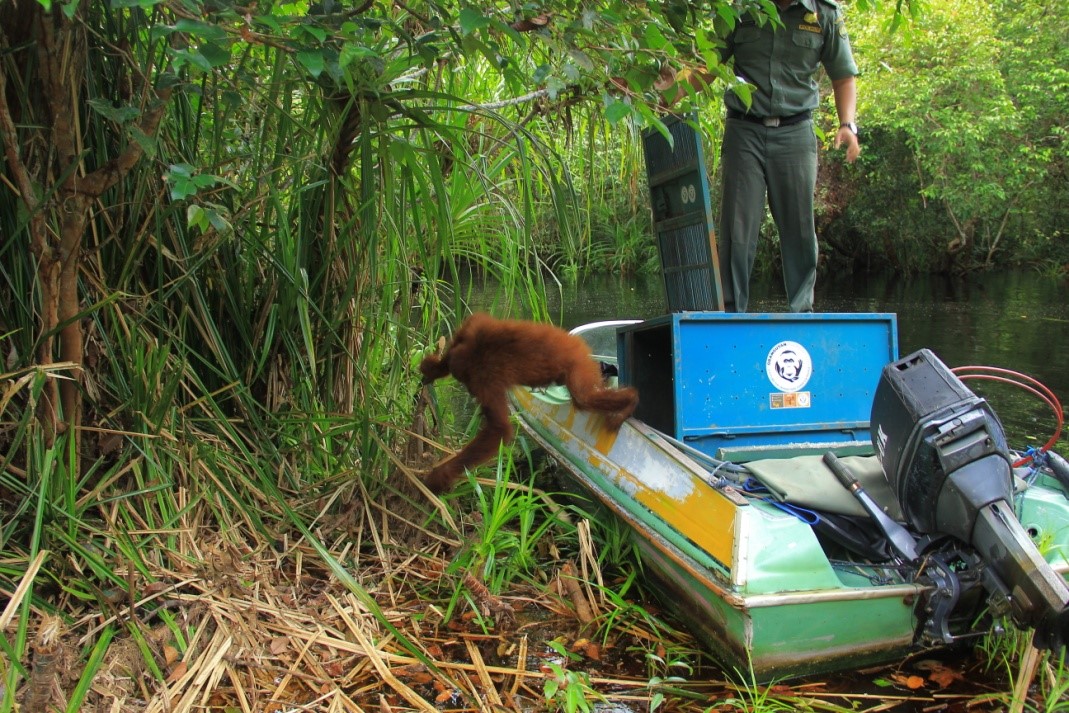
Watch this clip to see how quickly the orangutan leaves the transport cage and disappears into the forest.
After the busy weekend with the translocation, Dr Dimas also spent time meeting and checking up on the young orangutans in our release camps. Here's a clip of young Satria playing in his night-time enclosure.
Wonder what the next week will have in store?
Thank you for supporting our work.
Donate to help us keep the Lamandau Wildlife Reserve and its precious orangutans and wildlife protected. Click here to donate - thank you.
An interview with Jakir - Patrol Manager, Orangutan Foundation
To finish off Orangutan Awareness Week, our final blog post is about Jakir, who oversees the protection of the Lamandau Wildlife Reserve and its precious inhabitants. He has been in this role for 10 years. Jakir is also a talented photographer and many of his images have been included in our new photobook, The Orangutan's World. Our committed Indonesian staff are the bedrock of all we do. Please donate to support our vital work, keeping forests standing and orangutans in the wild.
Jakir, Patrol Manager Orangutan Foundation
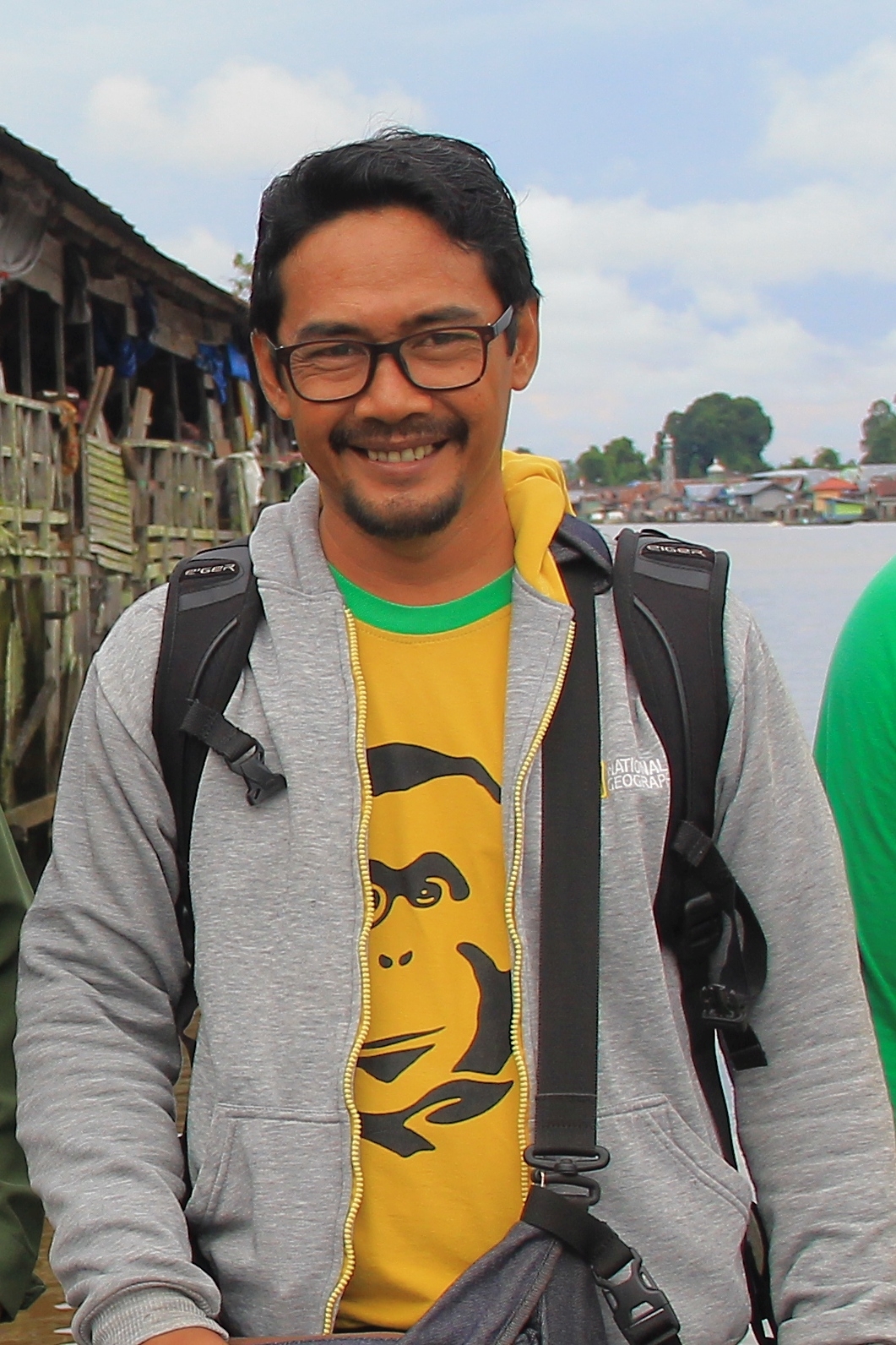
My role as Patrol Manager is to supervise the 12 staff who occupy our eight guard posts, ensuring that they are well maintained and operated, so that the wildlife reserves are protected from illegal activities, such as logging, mining, hunting and fishing.
It’s a very important role and I most of all I love the interaction with the local community in the field. Sometimes ignorance is the reason for illegal activities, and we tell people what we are doing so they also understand why we are protecting the forest.
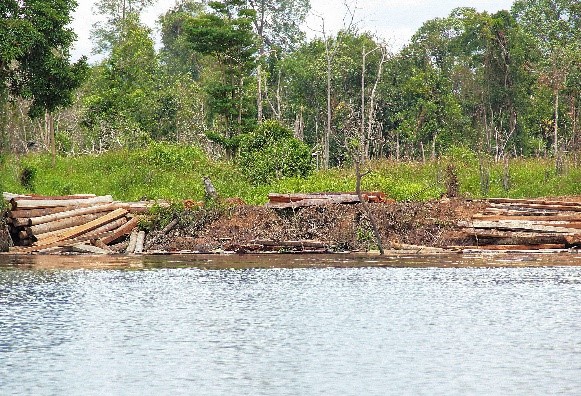
But the biggest challenge is facing people who deliberately do illegal activities. We have faced threats and bribes, but some people who were previously involved in illegal forestry now give us information on illegal activities they encounter.
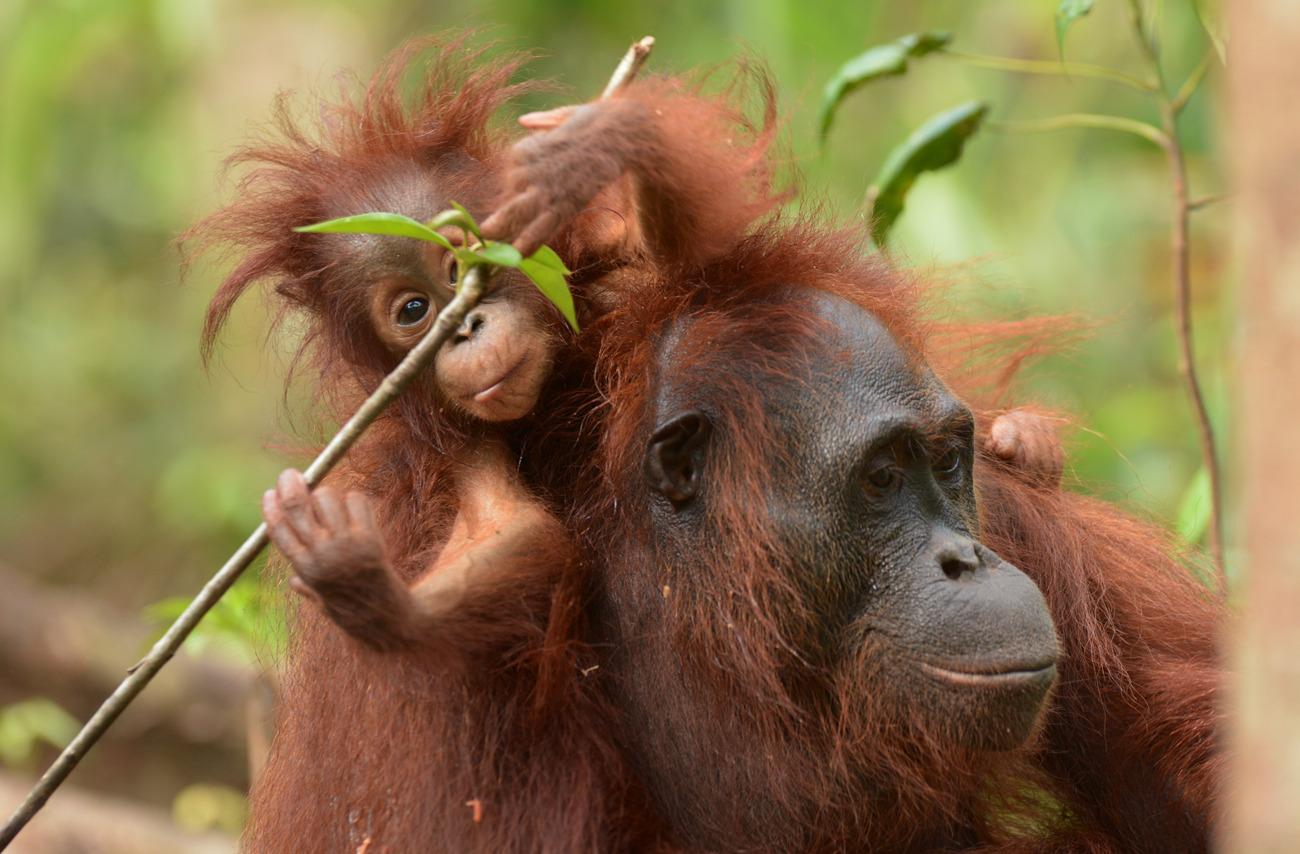
It’s very special to see some of the animals that we have saved roaming free in the forest in Lamandau.

When I first met Ashley, the Director of the Orangutan Foundation, I didn’t understand why she talked so much about protecting the forest and sacrificed so much of her own time for this. But a long time afterwards I saw some villages submerged by flooding and I realised why protecting the forest is so important.
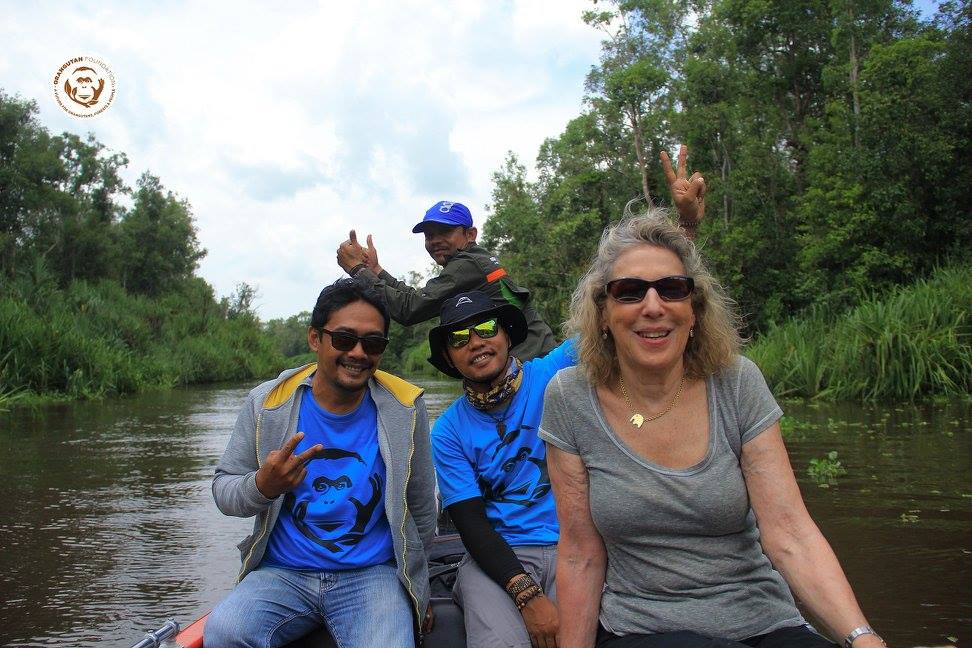
My hope is that the forest will always be alive and awake, so that my grandchildren can see and feel the coolness of this forest.
Written by Anna Levin, this interview was featured in our latest member's newsletter, Red Ape, Autumn 2017.
By donating £16.50 a month you can become a Guardian of the Lamandau Wildlife Reserve and support the protection of over 150,000 acres of tropical forest habitat. Click here to find out more.
Meet Aan the orangutan
To celebrate Orangutan Awareness Week, we are telling the stories of some of the orangutans who have been given a second chance thanks to your support for our work, but unfortunately, not all have a second chance in the wild. Aan
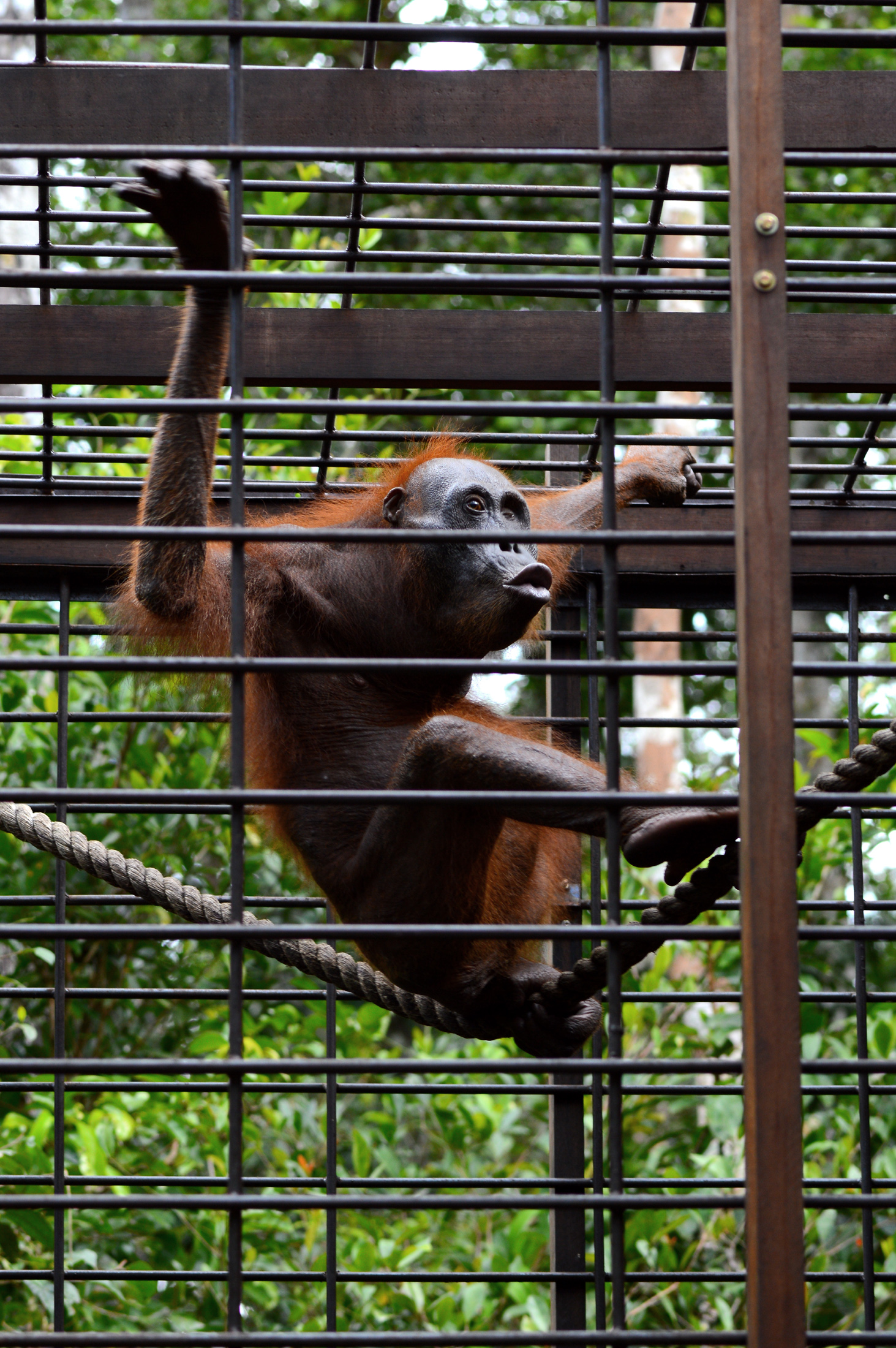
Aan is a blind orangutan. She first came to us in 2012, having been found stranded on an oil-palm plantation, after being shot over 100 times with an air gun. The injuries sustained left Aan blind. You can read more about her rescue here.
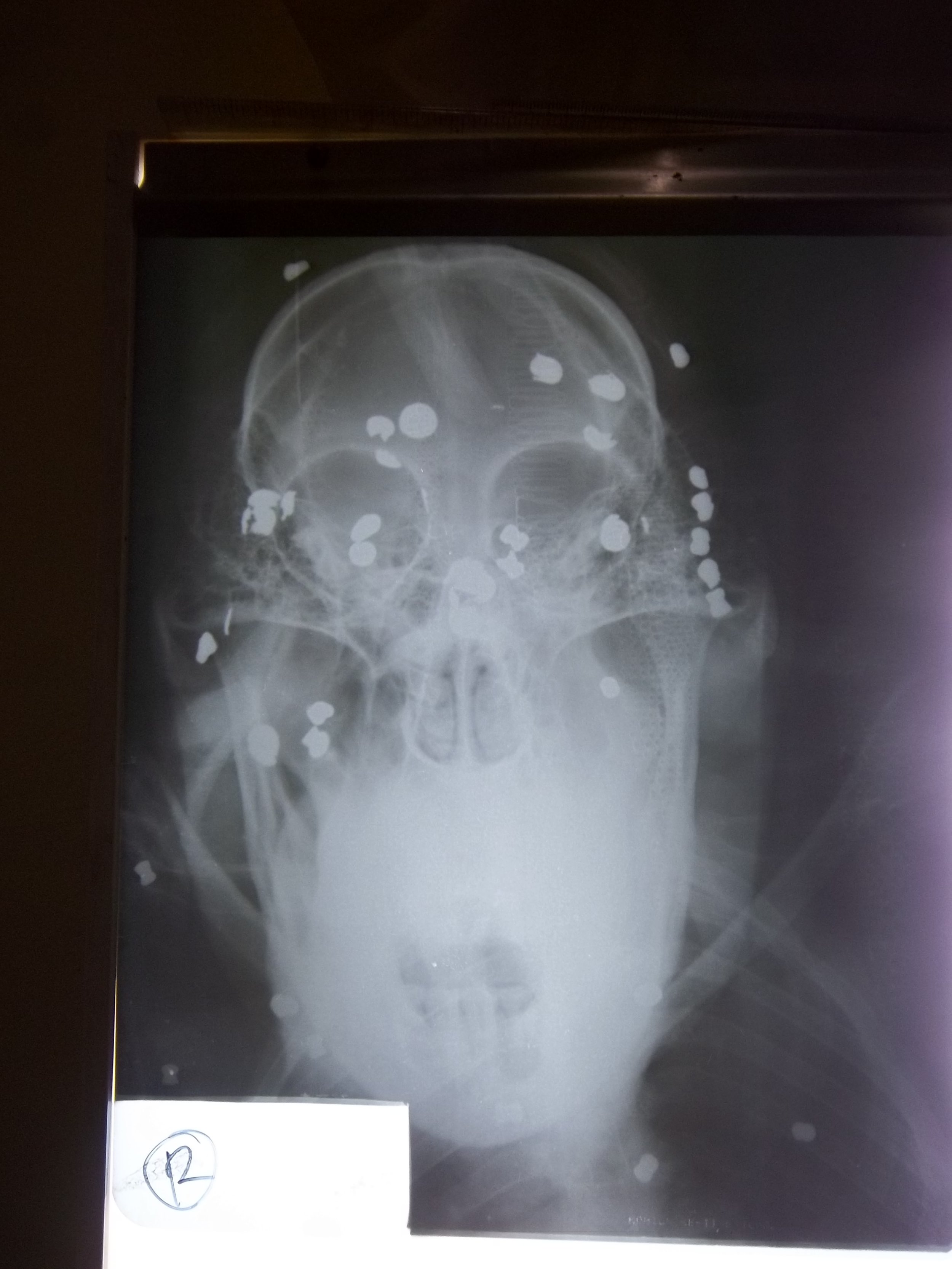
In 2016, we arranged for an ophthalmic surgeon to visit Aan to see if there was any chance of restoring her sight, with the hope that one day she could return to the wild. Aan underwent surgery but it soon became clear that the damage sustained was too severe and Aan would be permanantly blind.
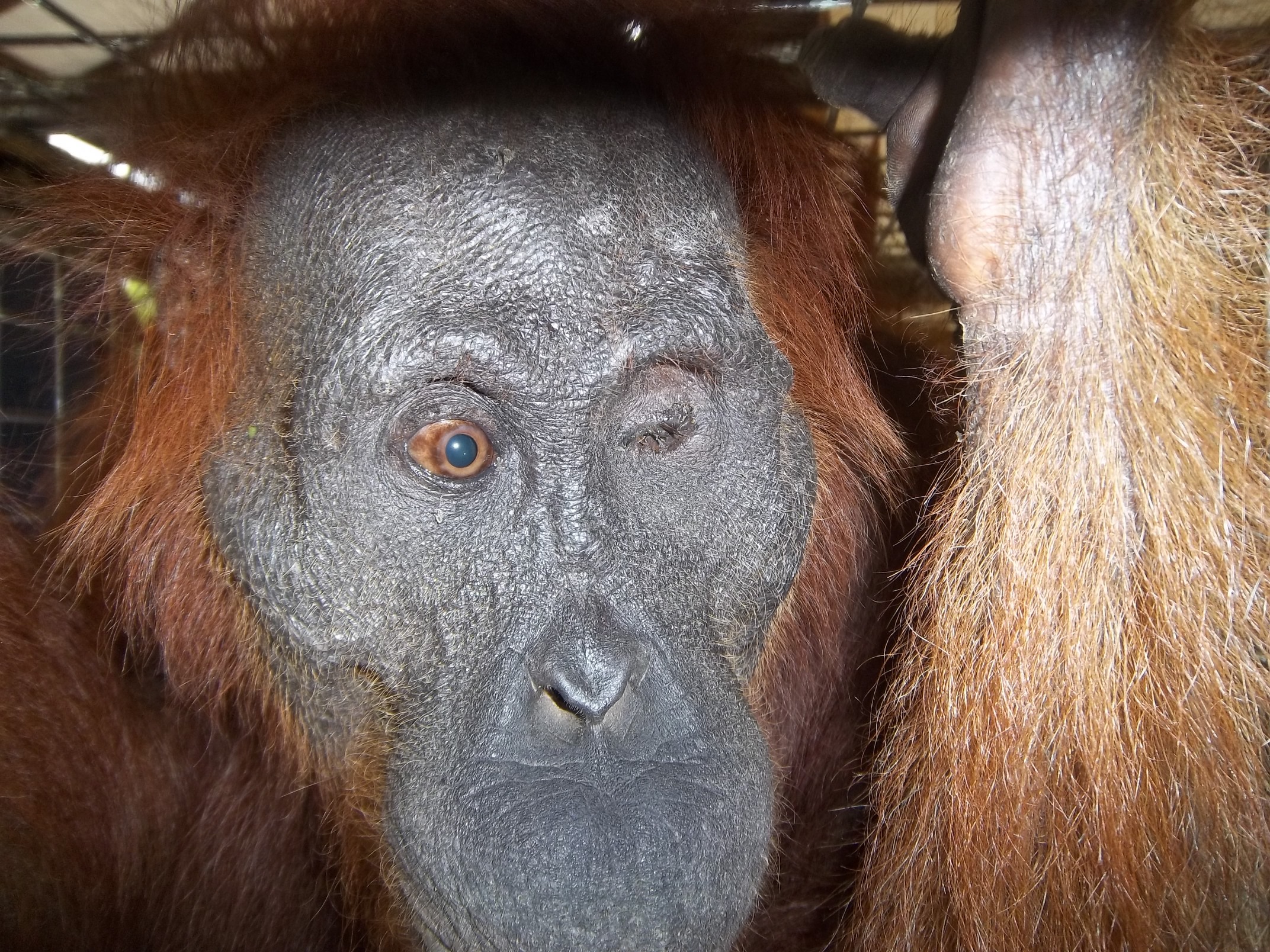
Aan lives in a purpose-built enclosure at Camp Gemini, where our vet clinic is located, in the Lamandau Wildlife Reserve. Our staff give her the best quality of life that is possible, but sadly Aan can never return to the forest, where she belongs.
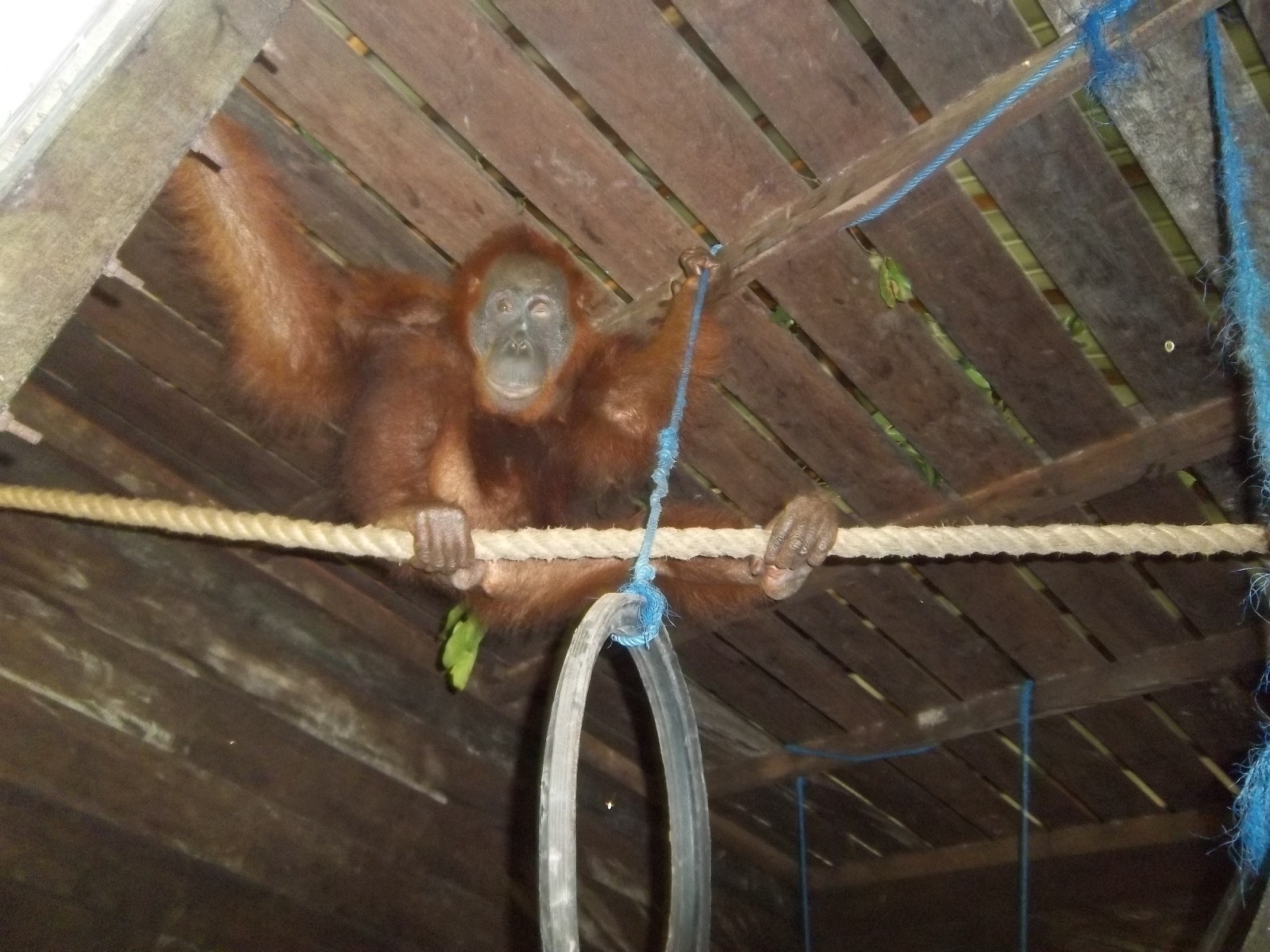
Aan’s story serves as a heartbreaking reminder that the threat to orangutans caused by habitat loss is a very real one. Please support our care of Aan during Orangutan Awareness Week by donating here.
Meet Kotim the orangutan
It is Orangutan Awareness Week and each day we will bring you a story about the orangutans in the Lamandau Wildlife Reserve. Thanks to your support we are protecting their forest home the Lamandau Wildlife Reserve and keeping them wild and free. Kotim
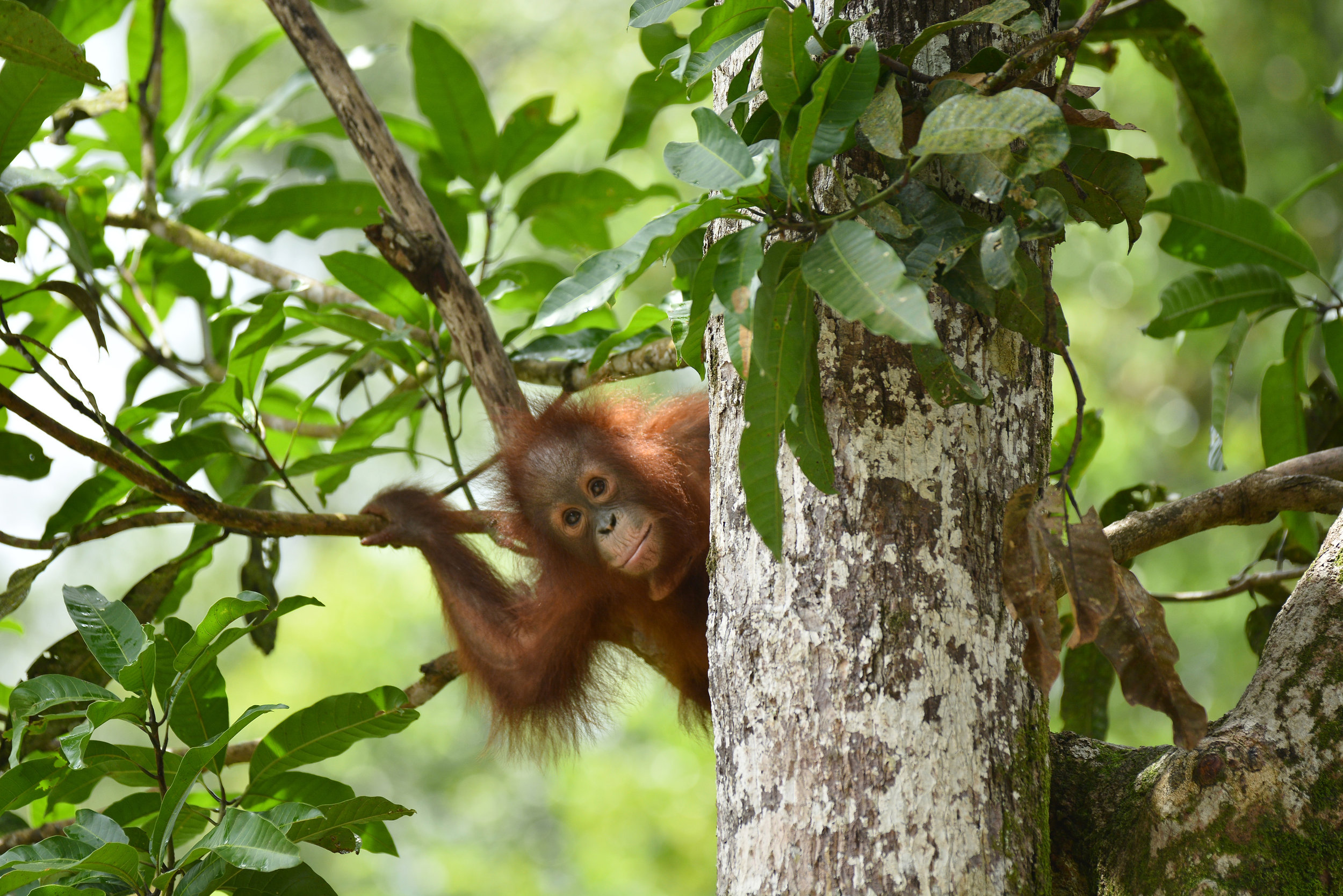
Kotim was rescued in 2014. She was handed over to Orangutan Foundation after being illegally kept as pet. Sadly, we can only assume that her mother was killed.
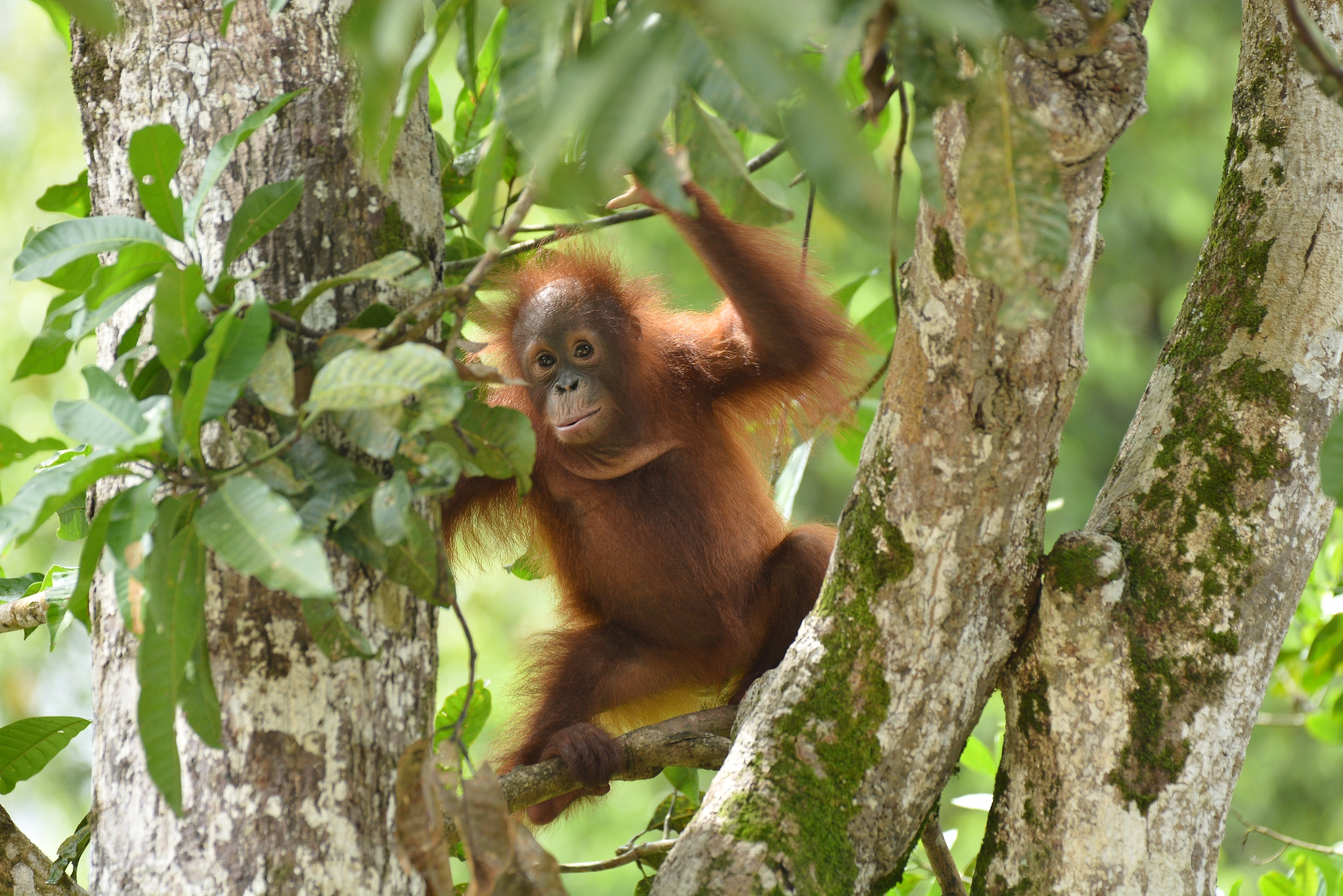
At three-years-old Kotim was too young to be released back into the wild and so entered into the care of our Soft-Release Programme, at Camp Rasak in the Lamandau Wildlife Reserve, Indonesian Borneo. Kotim joined another infant orphan, Torup. They became playmates and together practised their nest-building and climbing skills.
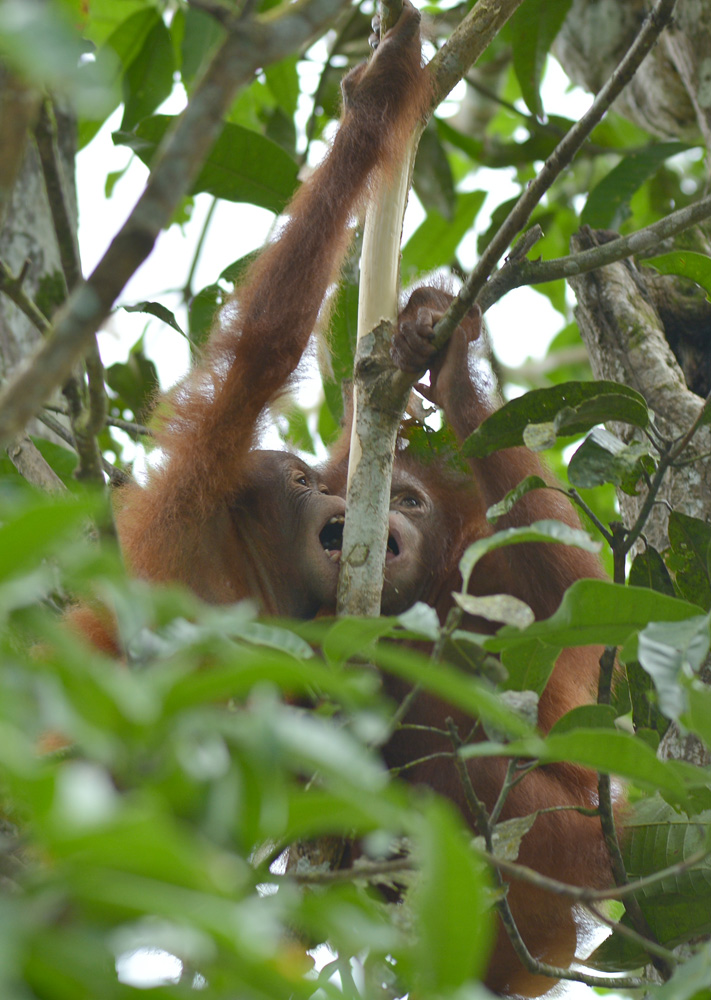
By April 2016, Kotim was deemed to have all the skills needed to survive in the forest and was successfully released. She is still occasionally seen by Orangutan Foundation staff. In December 2016, Kotim was seen with adult female orangutan Acuy and her infant, Ariel.
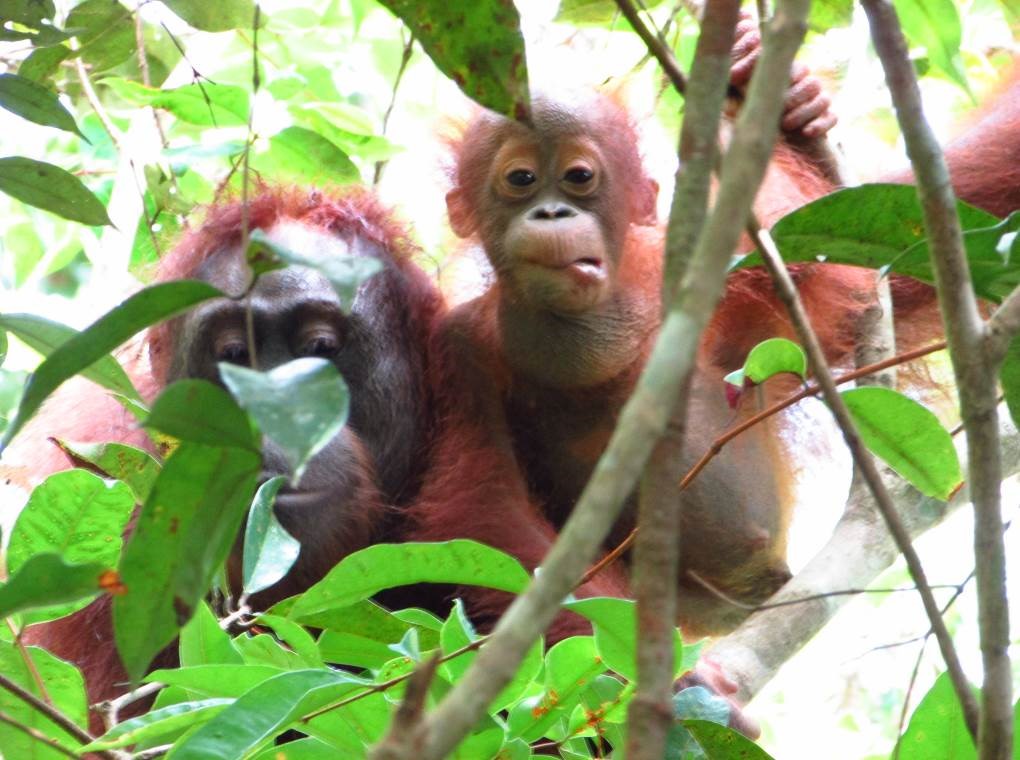
Support Kotim during Orangutan Awareness Week. Please donate to help us protect her tropical forest home. Keep forests standing and orangutans in the wild.
Please donate here.
Here's a video of Kotim whilst under our care in our Soft-Release Programme:
Meet Bangkal the orangutan
To celebrate Orangutan Awareness Week, we are telling the stories of some of the orangutans who have been given a second chance thanks to your support for our work. Bangkal
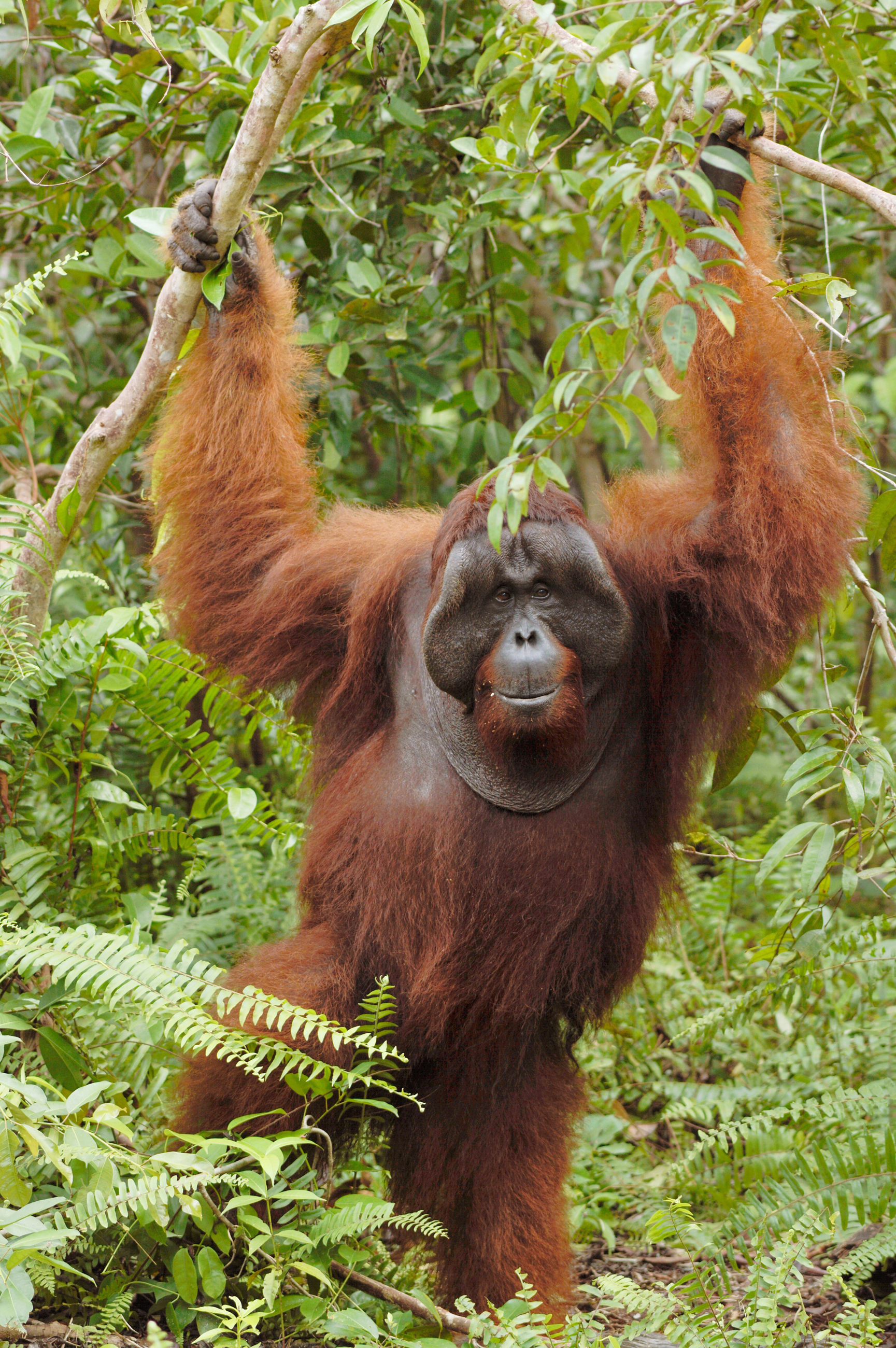
In the late 1980’s Bangkal was an orphaned infant, being kept as a pet. He was rescued, rehabilitated over many years, and then released into Tanjung Puting National Park, Central Kalimantan Indonesian Borneo.
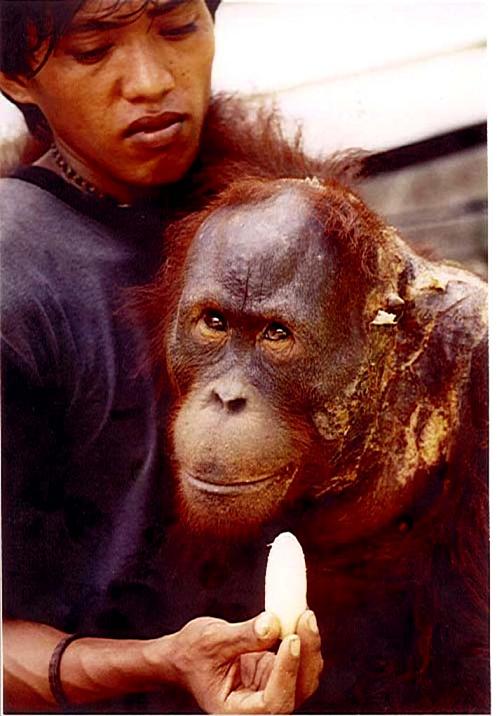
In 2000, when illegal logging was rife in Indonesia’s National Parks, Bangkal became the victim of a horrifying incident. Illegal loggers threw hot oil over him resulting in a burn down his face and neck.
During his recovery, Bangkal protected himself from annoying insects, by using a blanket to cover his injured face. Once recovered, Bangkal was released again but this time into the Lamandau Wildlife Reserve.
Now aged around 28 years-old, cheek-padded Bangkal is magnificent. He is the dominant male around Camp Gemini and is thought to have fathered many offspring.
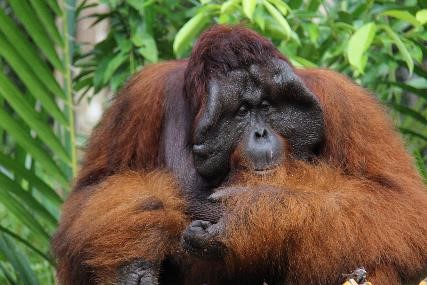
Support Bangkal during Orangutan Awareness Week! Please donate here to help us protect Bangkal in his forest home.
Meet Holahonolulu the orangutan
To celebrate Orangutan Awareness Week, we are telling the stories of some of the orangutans who have been given a second chance thanks to your support for our work. Holahonolulu
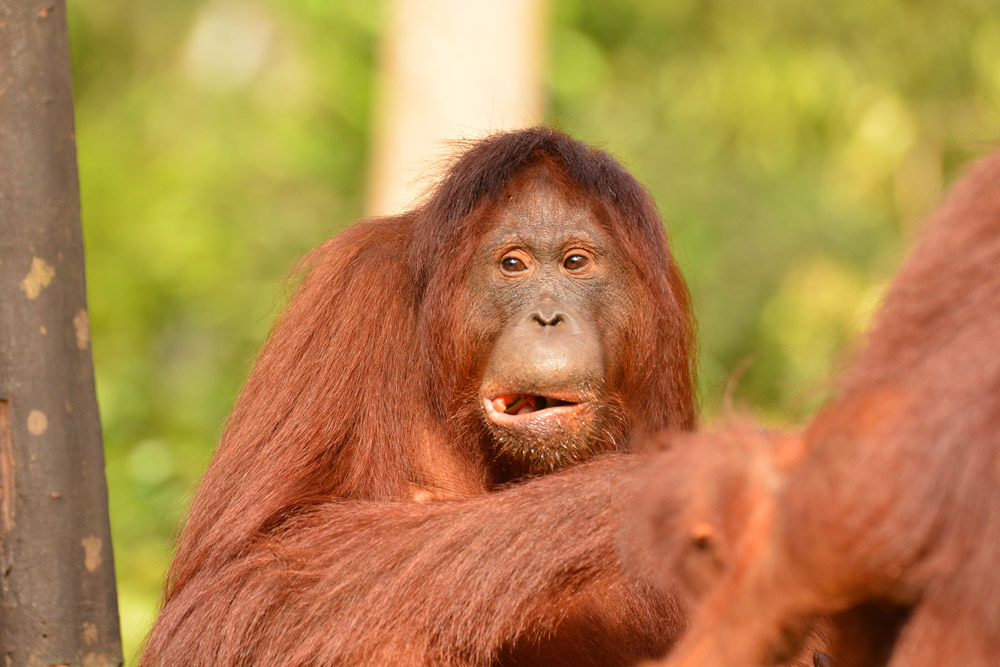
Holahonolulu is a wild born adult female orangutan. Her mother, Huber, was released into the Lamandau Wildlife Reserve in around 2000 and Holahonolulu was born in 2004. Huber unfortunately passed away in 2012.
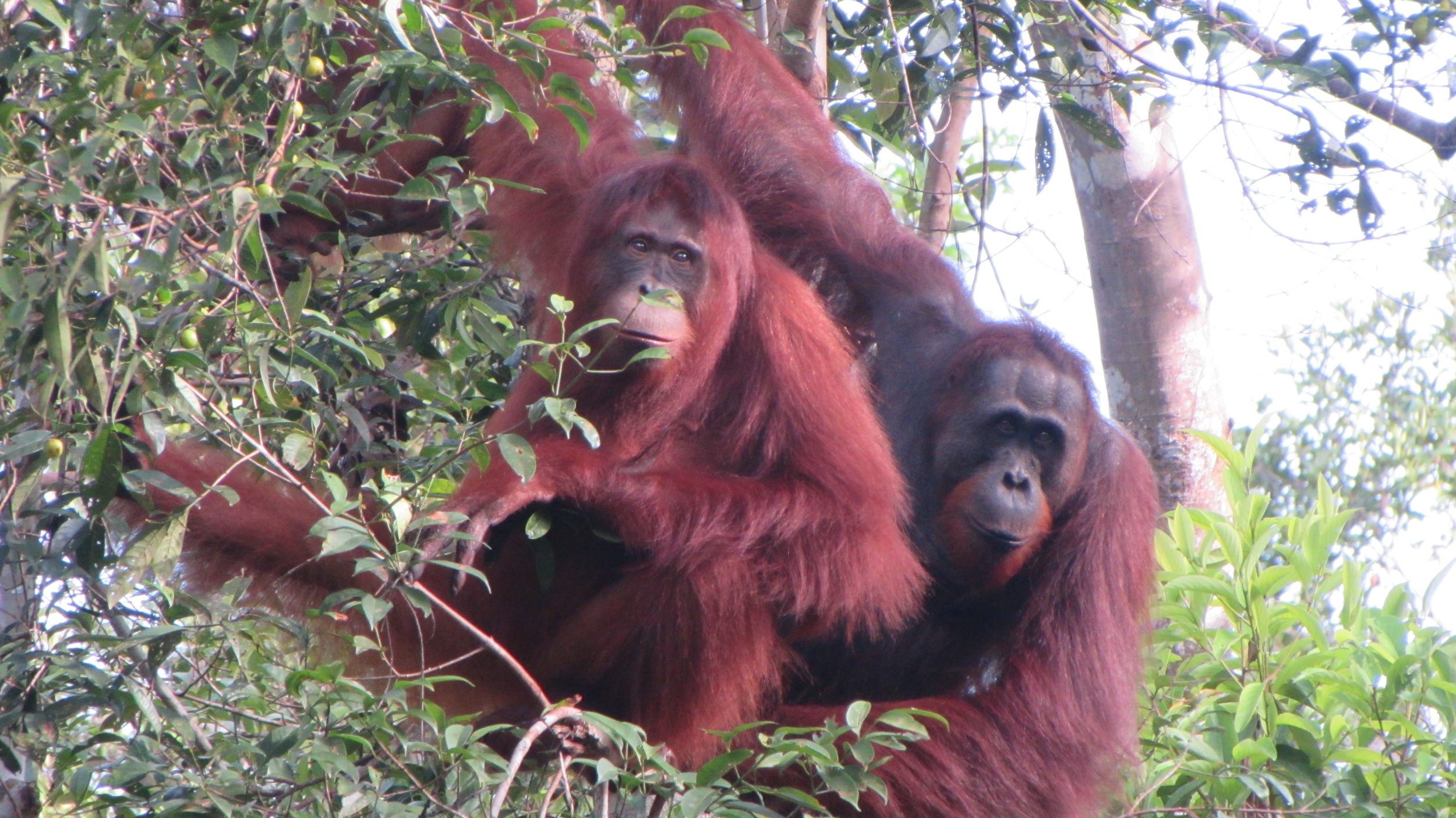
Holahonolulu is often seen by Orangutan Foundation staff at the feeding station, close to Camp Gemini. She been observed with Bangkal, a dominant male, mating on several occasions. Orangutans have a gestation period of about 9 months, it is slightly shorter than humans. Watch this space for the announcement of a new arrival in a few months’ time!
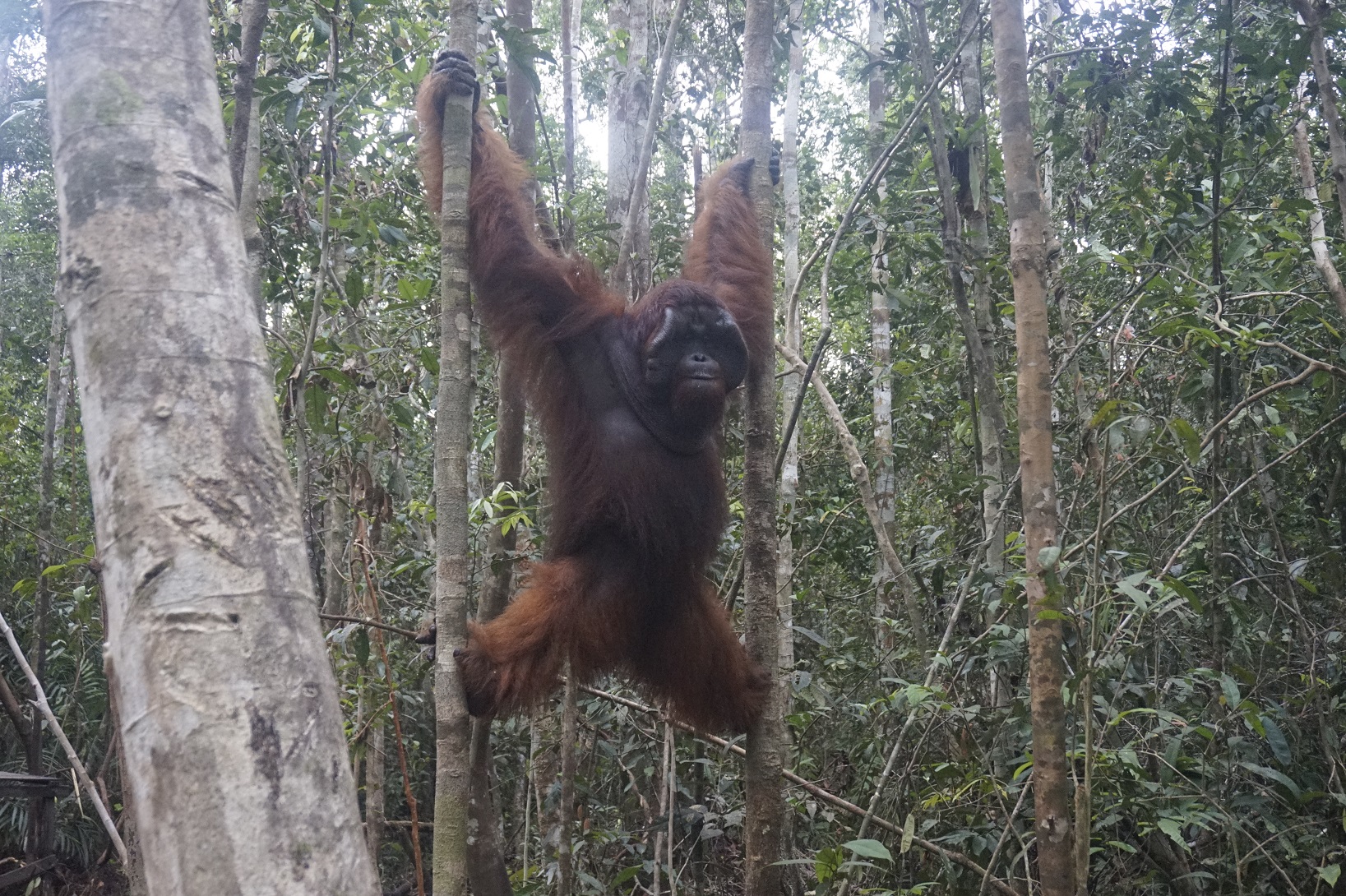
We are delighted when released orangutans go on to produce future generations. The orangutans of Lamandau Wildlife Reserve are now a healthy, viable and growing population.
Support Holahonolulu during Orangutan Awareness Week here! Please donate to help us protect her tropical forest home.
Freedom in the wild
If you want something done, ask a busy person. This expression is especially true for Orangutan Foundation Director, Ashley Leiman OBE, who has just returned from a field visit to our programmes in Central Kalimantan, Indonesian Borneo. One of the highlights was a tree planting ceremony to celebrate the planting out of over 22,000 seedlings in degraded forest habitat in the Lamandau Wildlife Reserve. The most memorable day though involved the return to the wild of seven different species. Captured from the wild and kept as pets, these animals had been confiscated by the Wildlife Department of Central Kalimantan (BKSDA Kalteng). The day was also a chance for Ashley to meet Bapak Adib Gunawan, the new Head of Wildlife for Central Kalimantan, who was overseeing the releases.
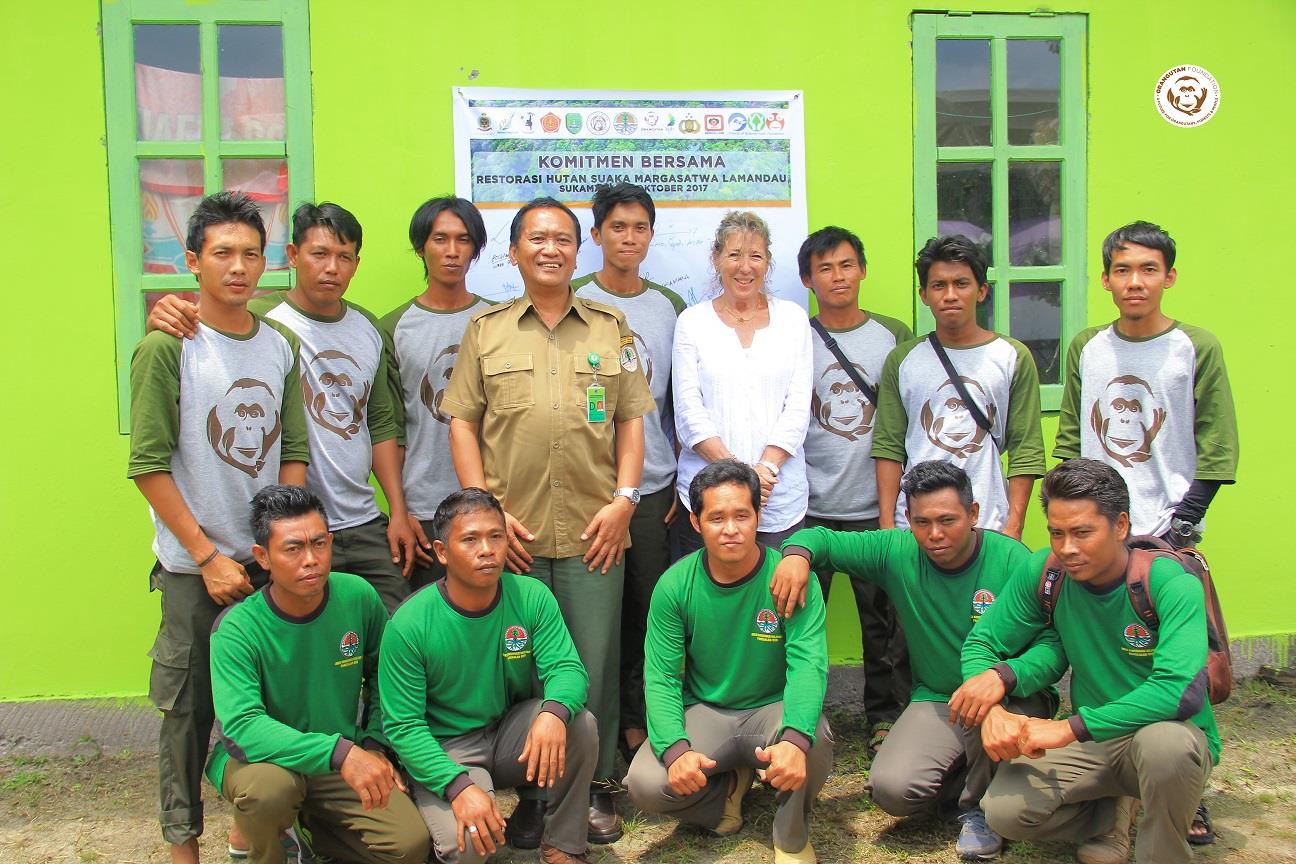
The animals due for release included two changeable hawk eagles, a hornbill, a pangolin, a slow loris, two reticulated pythons, a sun bear and a young orangutan.
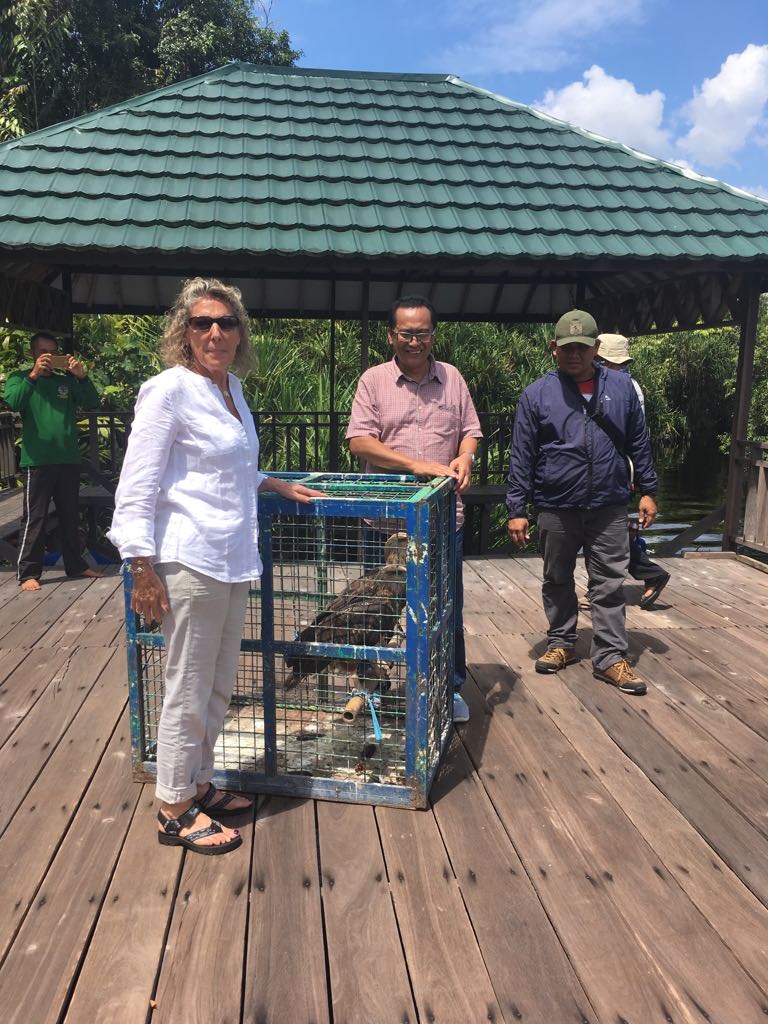
The orangutan, a handsome young male of around one-and-a-half years old, had been kept as a pet in a nearby town. He was named Adib, after the new Head of Wildlife, and has joined our Soft-Release Programme at Camp JL, in the Lamandau Wildlife Reserve, where he’ll learn the skills to survive in the forests.
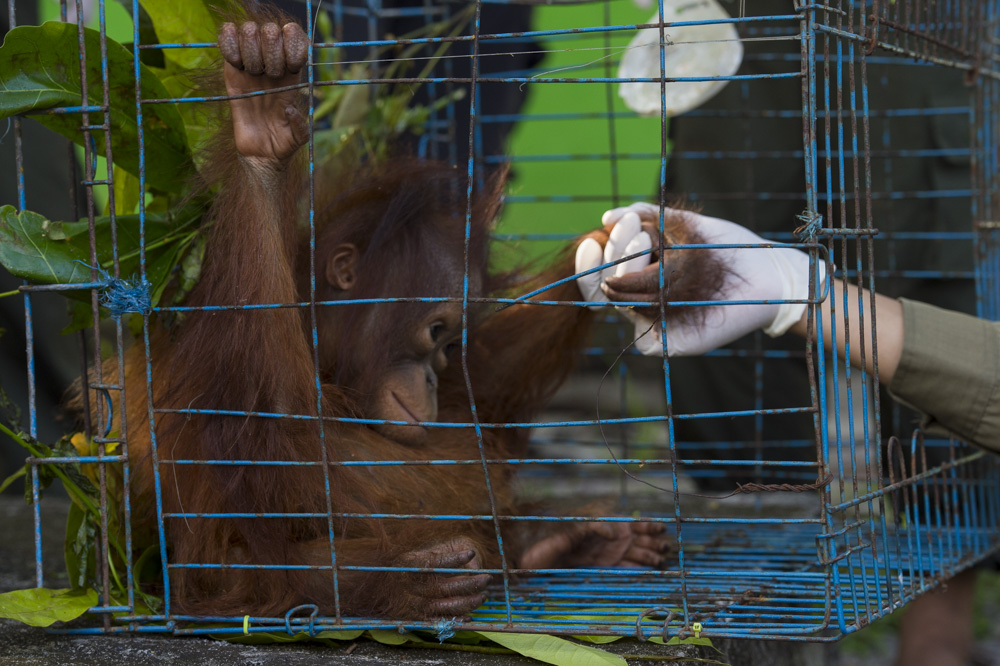
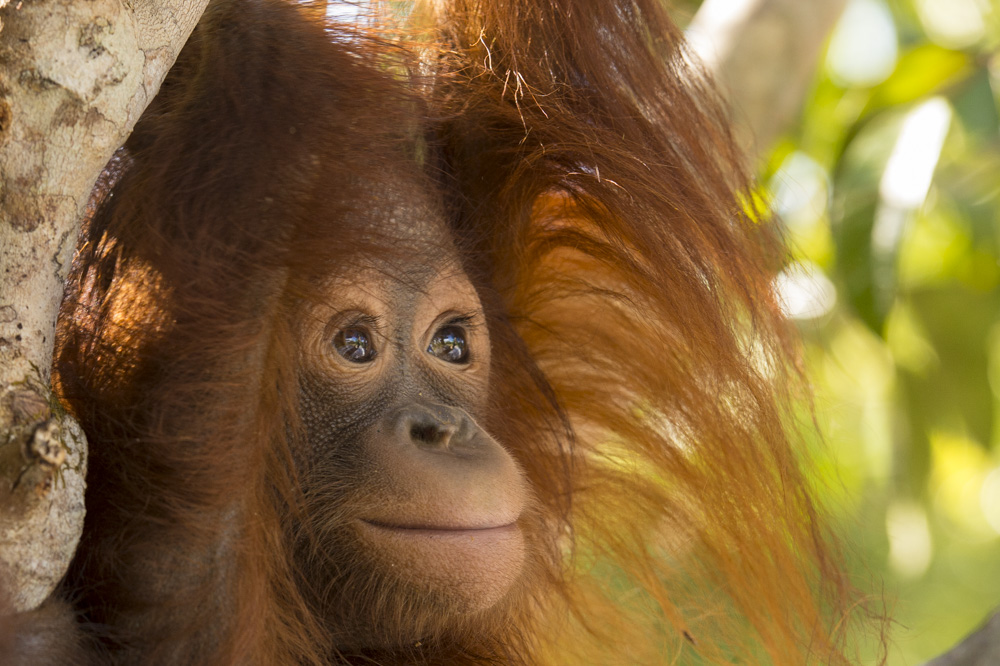
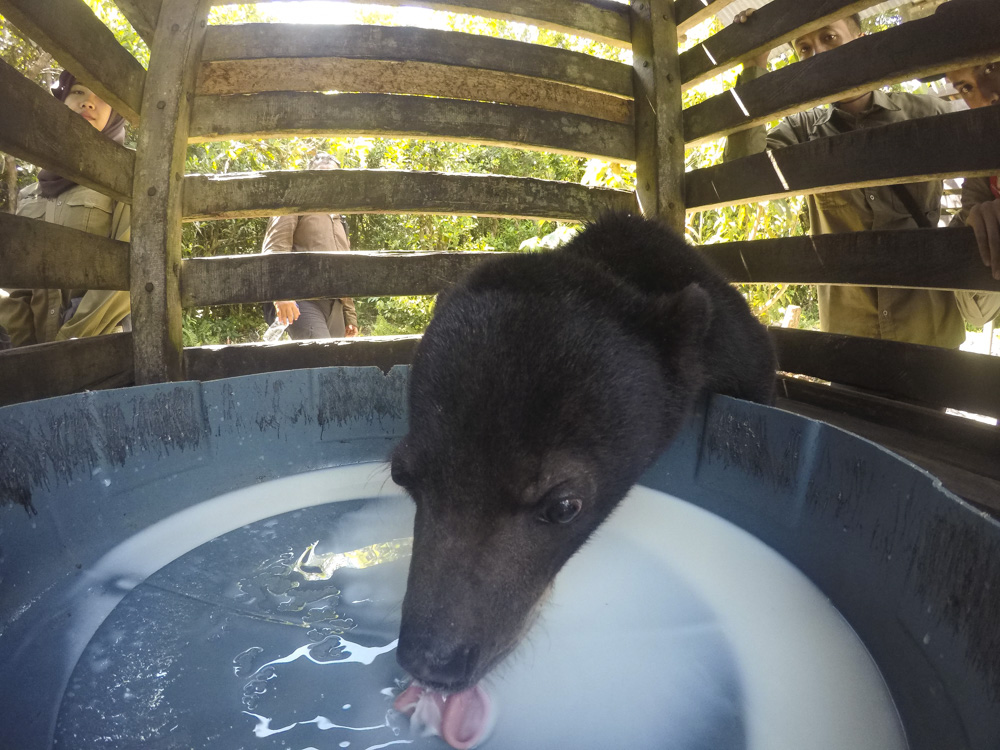
A playful sun bear, named Paddington (also a pet), was taken to Camp Siswoyo, where Orangutan Foundation staff will care for him until he is old enough to live independently. The slow loris, being a nocturnal primate, was released after nightfall.
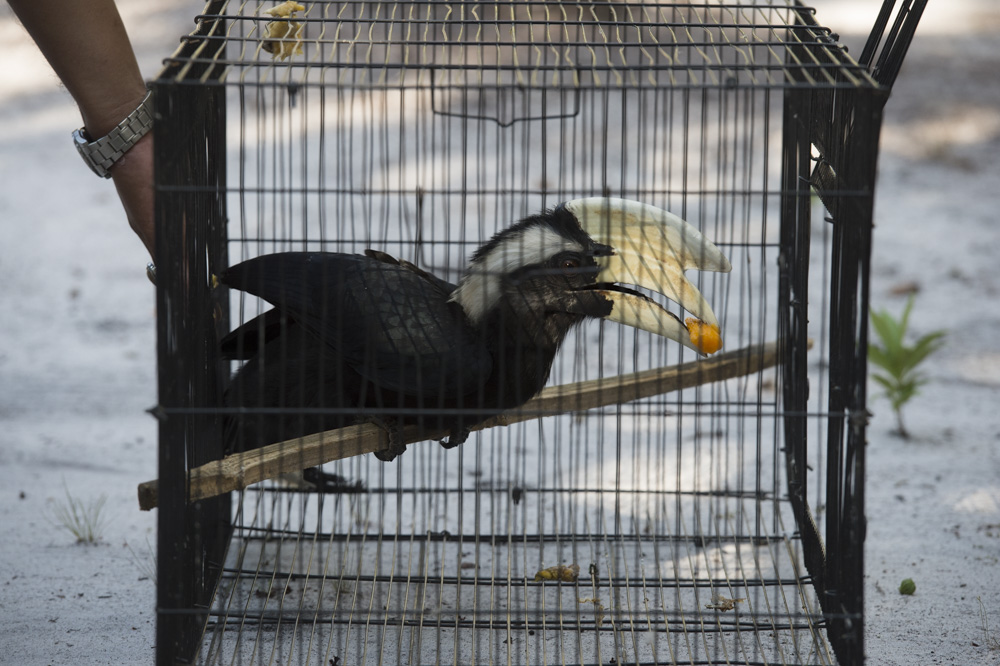
The changeable hawk eagles and hornbill were released from a guard post in the reserve, and Ashley opened the slide door to the crate of the pythons.
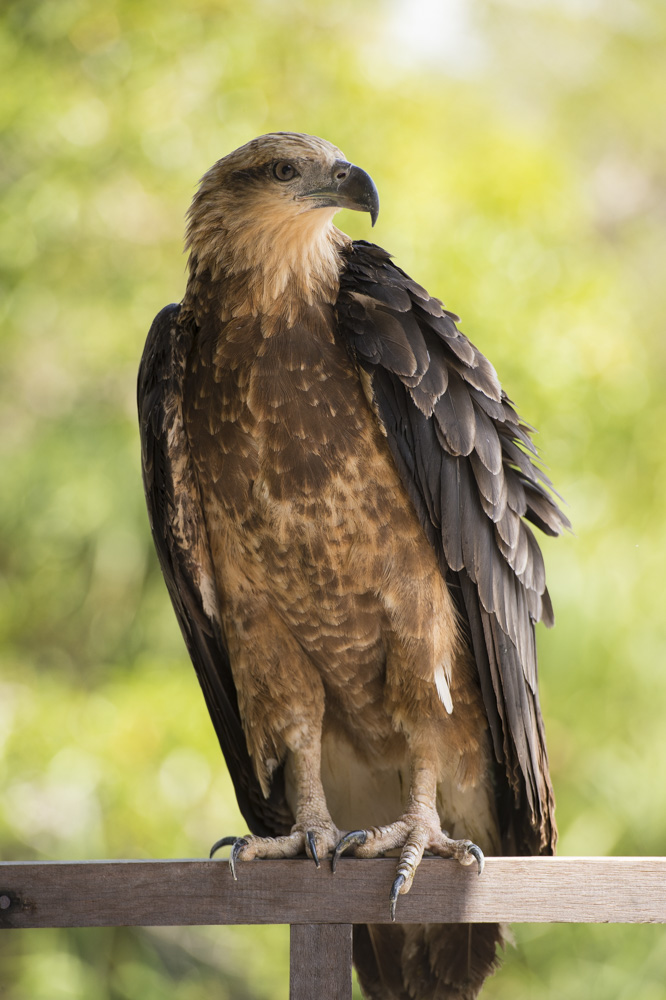

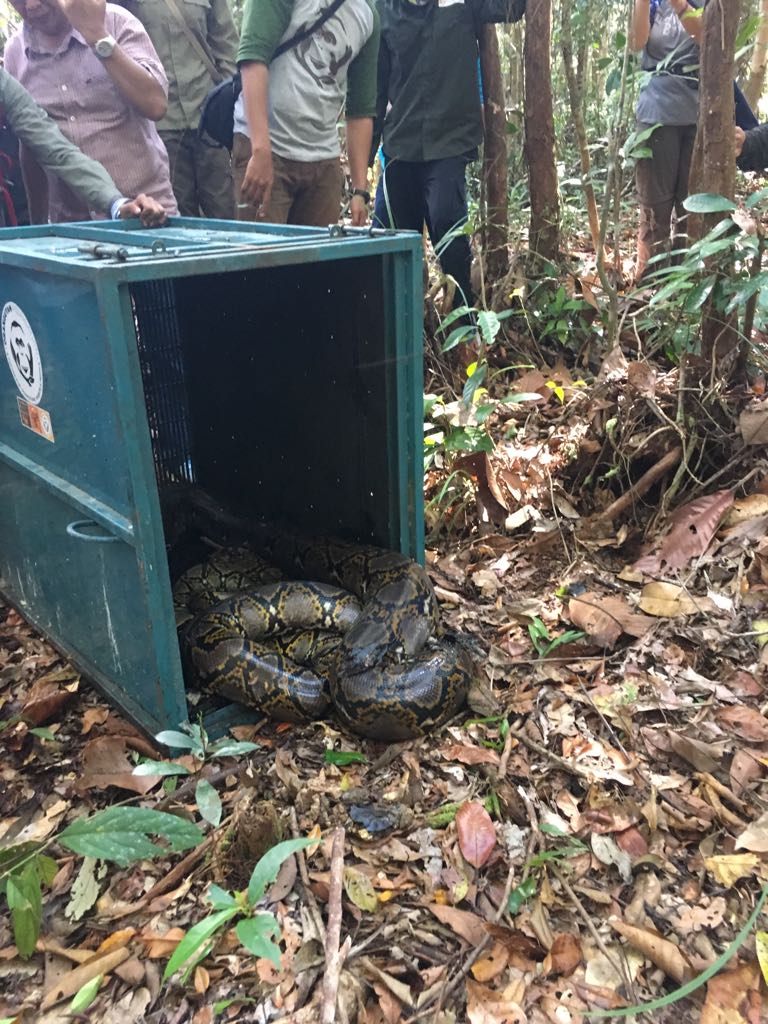
Over 3 meters in length, Ashley questioned why anyone would want to keep the snakes as a pet! We’ll post a separate blog on the pangolin, so watch this space.
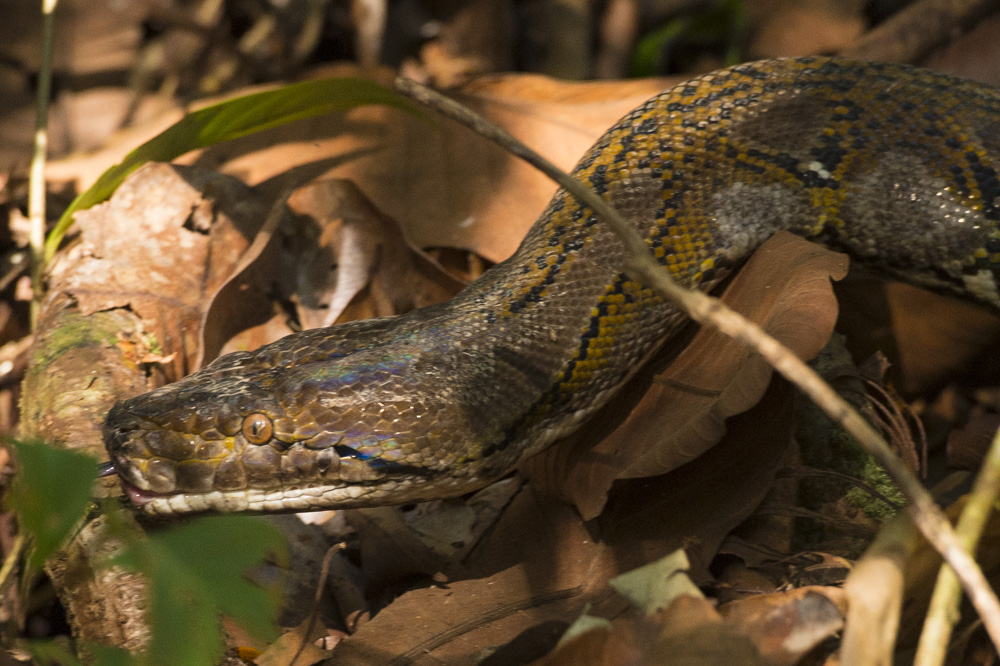
Ashley pointed out that our work for these animals has only just begun. Through our habitat protection work we must ensure that the forests stay standing, so the wildlife stays in the wild.
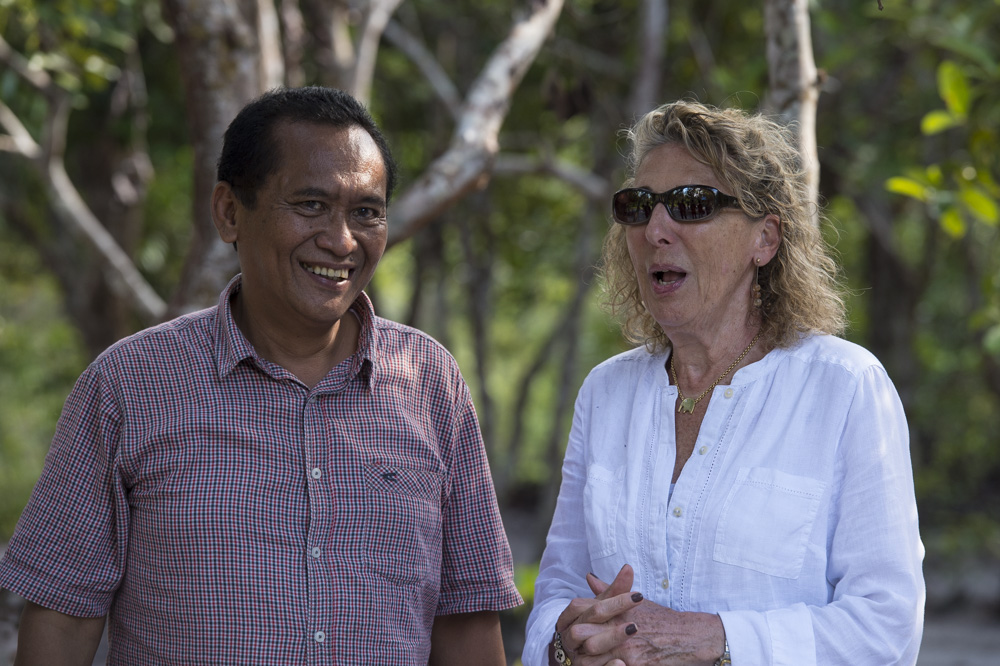
Please support our work, donate now.
Thank you.
Q&A with the Programme Manager of the Orangutan Foundation
People's Trust for Endangered Species (PTES) have been supporting the Orangutan Foundation's work in Indonesian Borneo for a number of years. We would like to share this Q & A with PTES and our Indonesian Programme Manager, Ade Soeharso, as part of the launch of their new appeal to save orangutan habitat.
Orangutan expert and Programme Manager at the Orangutan Foundation, Dr Ade Soeharso, answers some questions about the lives of orangutans, the dangers they are facing and ways anyone can save them now.
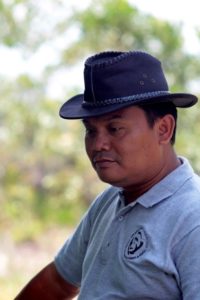
When did you start working at the Orangutan Foundation?
I’ve been a partner of the Orangutan Foundation since 2006. I was still working for the government then. Between 2008-2014 I worked part-time as a technical advisor of the Orangutan Foundation, and since 2015 I’ve worked full-time for the Orangutan Foundation.
What is the ideal habitat for an orangutan?
The ideal orangutan habitat is a mixture of swamp forest, lowland dry forest, and mountain forest. Ideally the habitat would be undisturbed and have an abundance of trees for food and nesting.
What is a protected forest?
In Indonesia, a protected forest is a one where the underlying area is protected from being logged or converted to other uses by land clearing.
What is palm oil? Why is the production of it so destructive?
Palm oil is a vegetable fat produced from oil-palm fruit. Almost all food products and many other common items use palm oil as a raw material. Therefore, palm oil is produced in large quantities because there is a huge market. Unfortunately, production of palm oil requires very large areas and which is achieved by cutting down large numbers of trees, which we call forest conversion and land clearing.
What have you found the hardest thing about working on the project so far?
The conservation of forests and the animals that depend on them is still often seen as less important than economic and development issues. It is challenging to mobilize the support of the parties in forest conservation efforts.
What is causing conflict between wildlife and the human population?
Due to deforestation, the amount of wildlife habitat left is ever decreasing. This means that the potential conflict between humans and orangutans will only increase. Orangutans and many other animals such as crocodiles, bears, and monkeys are forced out of the degraded forest and end up in community settlements and plantations in search of food. Seen as pests, they are often shot. We make sure that where possible, wild animals are translocated back into safe habitat. This is only possible if there is safe habitat left to move them back to.
What do you enjoy most about working with orangutans?
I enjoy it so much when I could see orangutans who have been rescued and then released growing and thriving in well-preserved habitat, successfully raising families of their own.
What time do you have to get up in the morning? Are orangutans early risers?
I get up early at 5:30 am. In the forest, orangutans rise between 5:00-5.30 am and leave their nests to set off in search of food.
How do you manage not to get lost in the forest when you’re following apes?
Basically, when following apes we’re never alone. There are always at least two people. As well as helping record data and times, they are locals who are more familiar with the forests so that we don’t get lost.
How many orangutans have you and your colleagues saved recently?
In 2017, so far we have saved 14 orangutans. Some of them have been released already as they are mature and well enough. The others are in the soft release programme. They are taken out into the forest each day to practice feeding and climbing until they have mastered the basic skills and are ready to be released.
Are you optimistic about the future for orangutans?
I am optimistic that orangutans can still be saved as long as we focus on saving their forests that are an integral part of their lives.
What must happen to ensure their survival?
We have to encourage the creation of sustainable oil-palm plantations and stop forest conversion in orangutan habitat and prevent the occurrence of forest fires. We also have to ensure that law enforcement act so that no more orangutans are traded as pets.
What can our supporters do to help?
As well as donating to this project, if you are buying a product that is made using palm oil, look out for ‘sustainable palm oil’ on the label. Currently, the global area already being used for oil palm production is sufficient to meet our needs without any further loss of forest. It is possible for us to use oil-palm produced from sustainable palm oil plantations and it is something we can all to do.
Please help us to help orangutans today so that they are still here tomorrow.
VIDEO - Orangutan Foundation's Rescue and Release of a Male Orangutan
We have received this footage from our field staff, of the rescue and release of an adult male orangutan, victim of habitat loss, found stranded in a narrow strip of forest between a village and oil-palm plantation.
Fantastic teamwork by everyone involved meant that this rescue was carried out safely, and the male orangutan was able to be released in the Lamandau Wildlife Reserve just two days later, in an area of protected forest habitat.
Help us to protect this forest reserve and ensure a future for orangutans, forests and people. Click here for more information.
Thank you.
Severely Malnourished Male Orangutan Rescued from Fragment of Forest in Indonesian Borneo
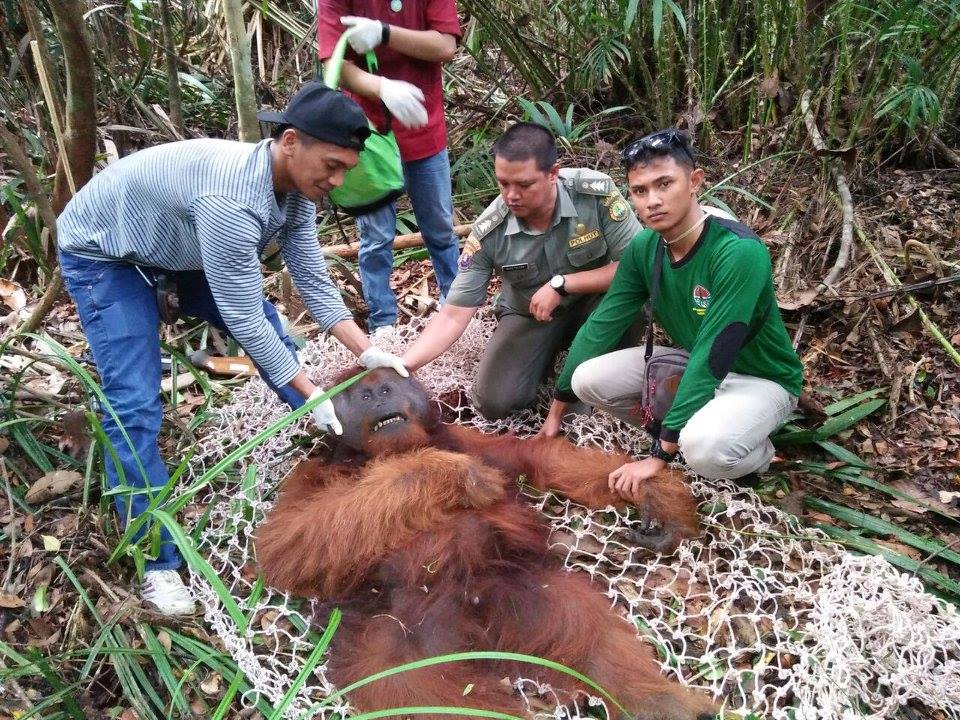 On Monday, 28th August 2017, Orangutan Foundation together with the local wildlife authority, managed to rescue an orangutan, found stranded in a forested area between a village and an oil-palm plantation in Central Kalimantan. The orangutan, an adult male of around 17 years of age, only weighed 80kg - about two thirds its expected weight..
On Monday, 28th August 2017, Orangutan Foundation together with the local wildlife authority, managed to rescue an orangutan, found stranded in a forested area between a village and an oil-palm plantation in Central Kalimantan. The orangutan, an adult male of around 17 years of age, only weighed 80kg - about two thirds its expected weight..
The alarm was raised by one of the villagers, who, seeing the orangutan so close by, was worried the orangutan would destroy his oil-palm plantation, and even enter his own home.
The challenging terrain made it difficult to reach the orangutan. The team had to use a boat to approach the area and then walk about 1km through swamp forest. On arrival, the orangutan was anesthetized to take it to a point of safety.
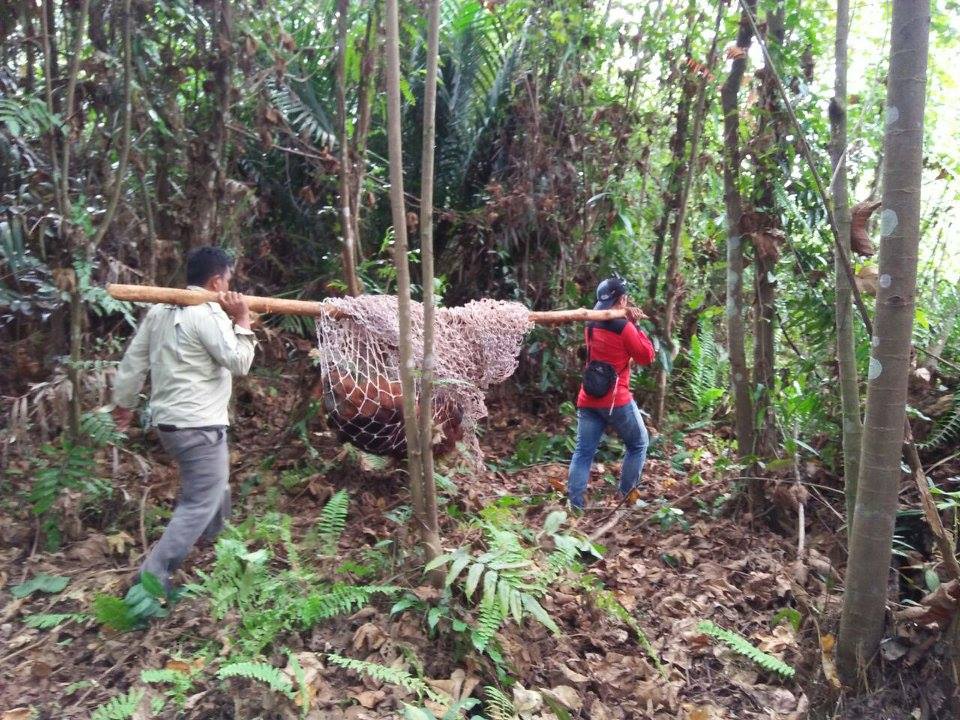
This rescue highlights the problem of habitat loss resulting in more wildlife coming into human contact, leading to human-wildlife conflict.
The orangutan will be examined by the Orangutan Foundation’s vet, and then translocated into the Lamandau Wildlife Reserve, a protected area on 30th August.
To date, 15 orangutans have been rescued in 2017, some being immediately translocated and others, too young for release, will go into the Foundation’s Soft-Release Programme. Please donate to support our rescue and release programme.
The Plight of Pongo Pygmaeus
We would like to share this post written by Justin Wateridge, Managing Director of Steppes Travel.

On Thursday many young people - perhaps a child, grandchild, niece or nephew of yours - received their A level results, but what does the future hold for them? Perhaps not one with pongo pygmaeus.
To you and me that is the Bornean orangutan which is now feared to have less than 50,000 individuals and hence last year it was listed as Critically Endangered on the IUCN Red List of Threatened Species, the highest risk category. We hear much in the news about elephant ivory, rhino horn and the hunting of lions but little or nothing of the enigmatic man of the forest.
Yet every year orangutan populations are threatened because of their habitat, low-lying tropical rainforest, is being destroyed and converted to oil palm plantations. Orangutans and the majority of biodiversity supported by tropical rainforests cannot co-exist with oil palm plantations. The use of fire to clear land for plantations is an additional risk to an already serious threat.
An encroaching human population is adding to the orangutans' habitat loss. Last year the Orangutan Foundation rescued many more threatened animals than they have before - only half of these were orangutans, the rest were a diverse range of forest creatures including sun bears, leopard cats and slow loris.
Having just come back from Indonesian Borneo, I met with the inspiring Ashley Leiman on Wednesday to see what more Steppes Travel could do to support the Orangutan Foundation UK the only one of six orangutan agencies in the UK that has permanent projects of the ground.
Given that today is International World Orangutan Day I would urge you to think about what you can do to help, either directly via the Orangutan Foundation's website or better still by travelling with your family as I did to see orangutans in situ or join our revamped Orangutan Conservation tour.
Yes you can see orangutans in this country but only in a handful of zoos - Blackpool, Chester, Colchester, Durrell and Twycross and we believe there is no substitute for doing so in the wild.
Participants of the Steppes Travel Borneo group tour will be joined by an expert from the Orangutan Foundation, offering exclusive insight into our conservation projects taking place in Central Kalimantan.
Alternatively, you can support our Forest Restoration Programme in Indonesian Borneo by purchasing a copy of our book: "The Orangutan's World".
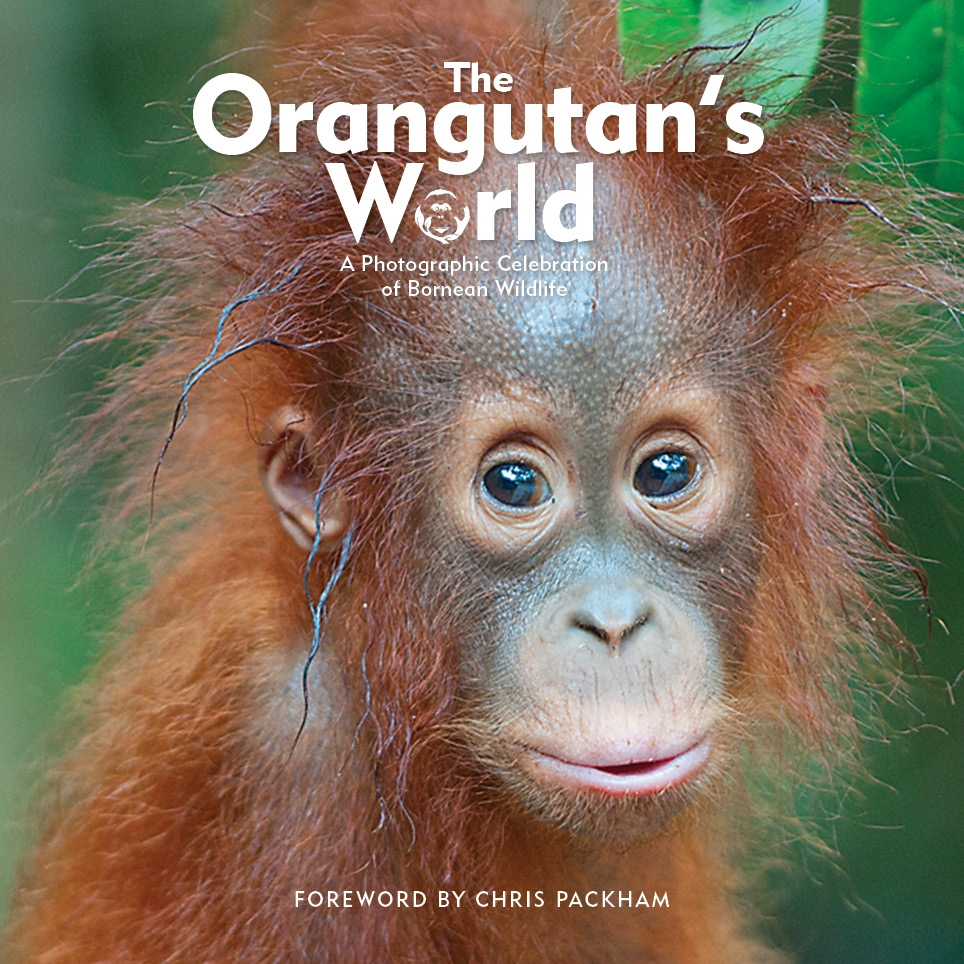
This wonderful book provides a glimpse into the world of the orangutan through a collection of photographs of the flora and fauna found in Indonesian Borneo.
Video: Dramatic orangutan rescue
This video shows the challenges faced by our staff when rescuing orangutans:
On the 3rd July, our staff received reports from the Wildlife Department (BKSDA) of yet another orangutan that had been found in community land. At that stage they had no idea of the difficulty of the terrain and where or what condition they would find the orangutan in. After preparing the anesthesia, our staff set off to the rescue location.
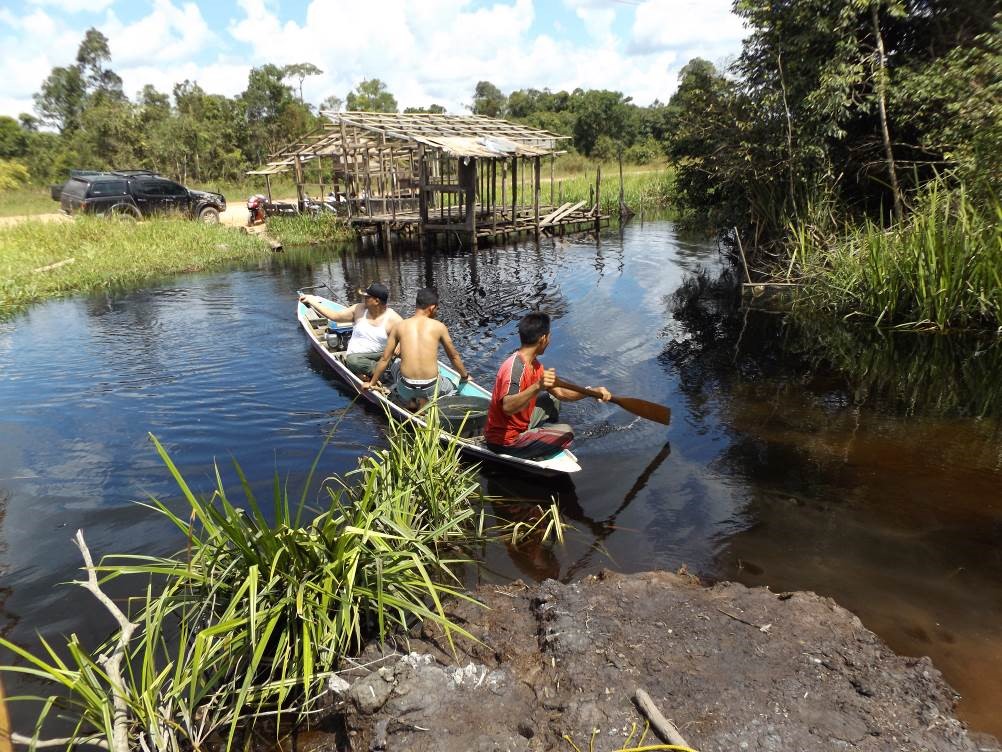
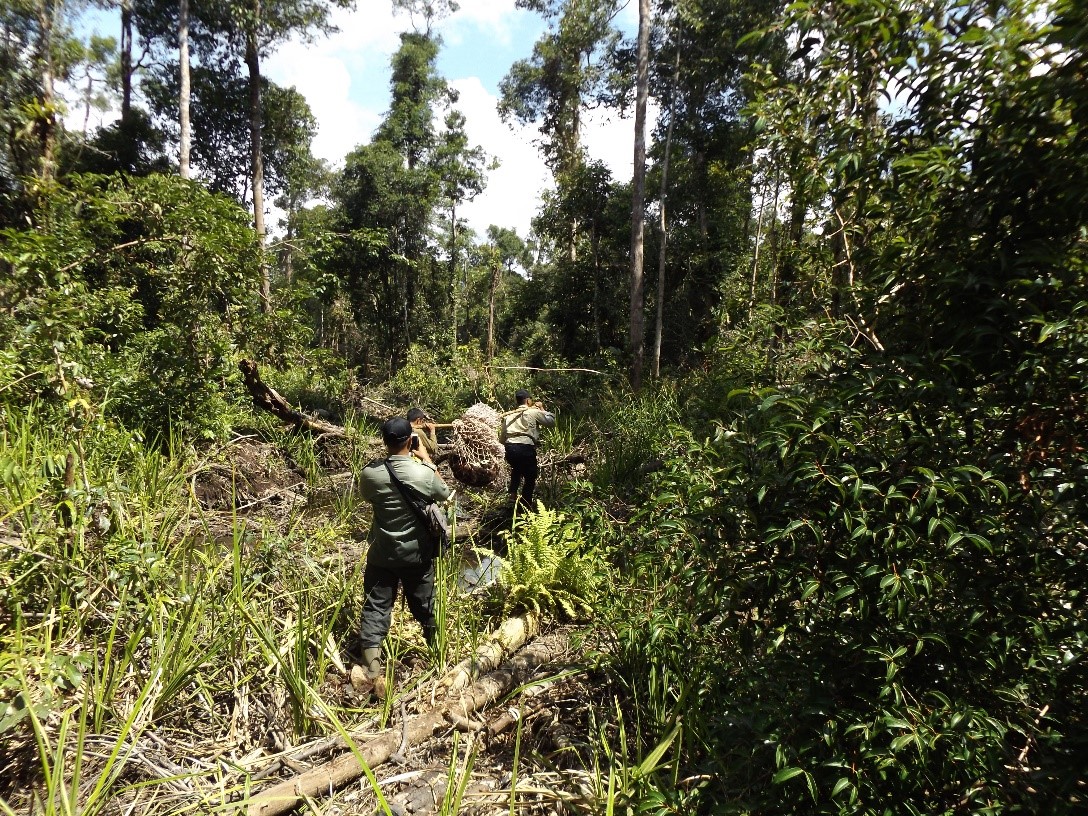
It soon became clear this was going to be difficult. They had to cut through dense undergrowth to reach the orangutan, which was high up in a tree. Our anaesthetist had to climb up a tree to get a clear sight of the ape before firing the dart gun. The staff, ready at the bottom of the tree with a net, caught the orangutan as it fell. Our vet was waiting to assess the orangutan, who was a female of around 20 years. Sadly though, he discovered previous injuries to her back and chest, which would require treatment.

The orangutan was named Karin and on returning from the rescue location she was examined and given treatment for her wounds.

After recovering from her ordeal, Karin was taken to Camp Gemini, an orangutan release site, in the Lamandau Wildlife Reserve (Central Kalimantan, Indonesian Borneo). Once Karin’s wound has healed she will be free to live back in the wild again.
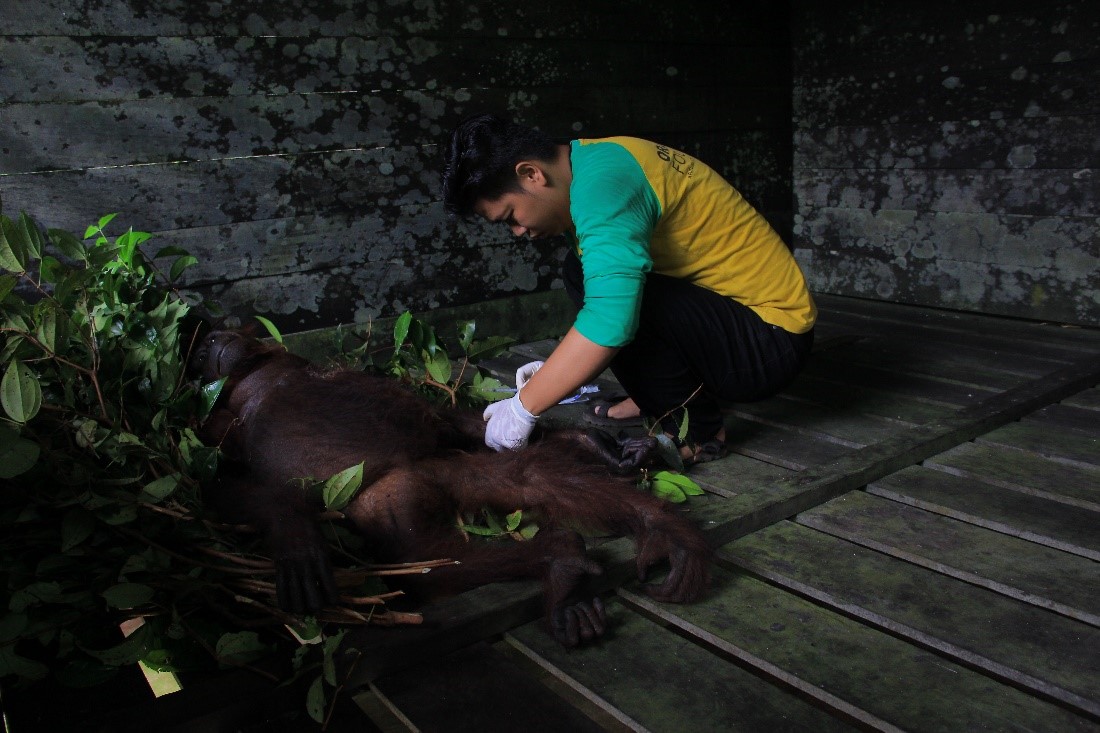
The loss of forest is causing orangutans to come into contact with humans as never before. Support the protection of Karin’s future forest home and become a Guardian of the Lamandau Wildlife Reserve.
Thank you.
Community Outreach in Tanjung Puting National Park
On the 22nd May, Orangutan Foundation field staff teamed up with Orangutan Green Teams and conservation cadets FK31 to run awareness activities with Sekonyer Village, within Tanjung Puting National Park. The primary aim of the activities was to educate and support the villagers activities to help protect the critically endangered orangutan and its threatened forest habitat. Community outreach is a cornerstone of the Orangutan Foundation’s work in Indonesian Borneo.
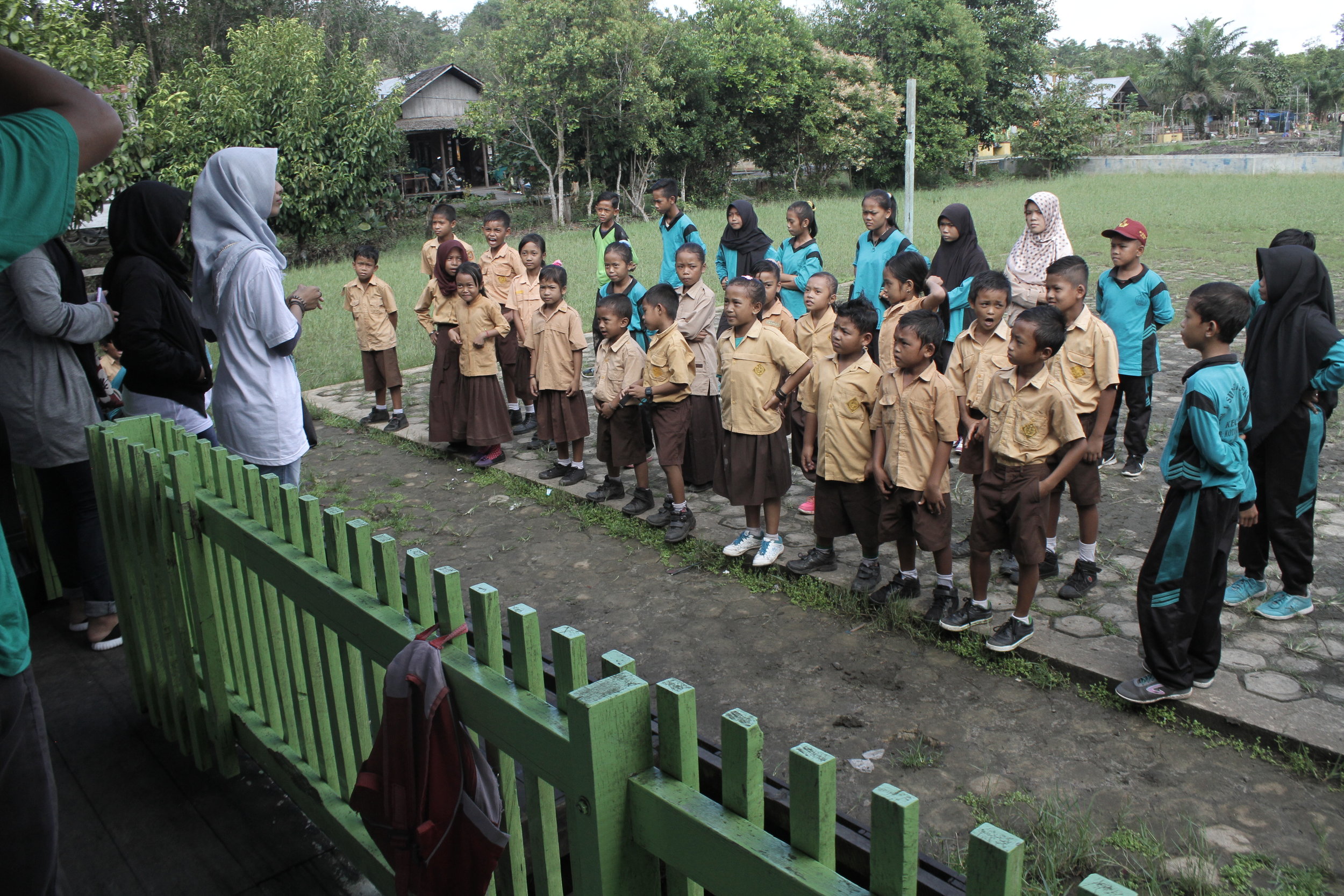

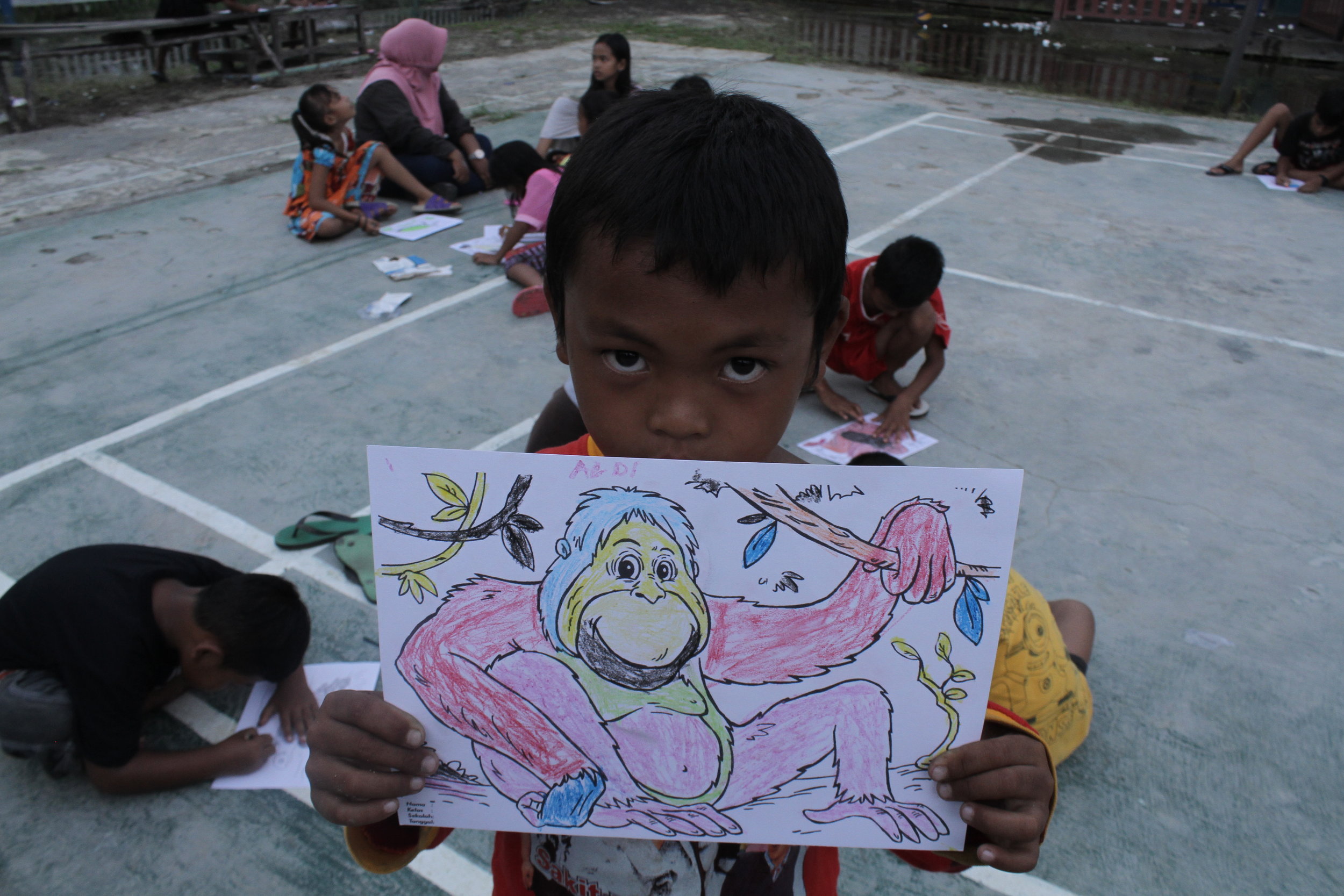

A variety of activities ensued, which included painting the village library and distributing books, as well as games for the children. The aim was to encourage members of the village to support ecotourism in the area as an alternative to habitat destruction.
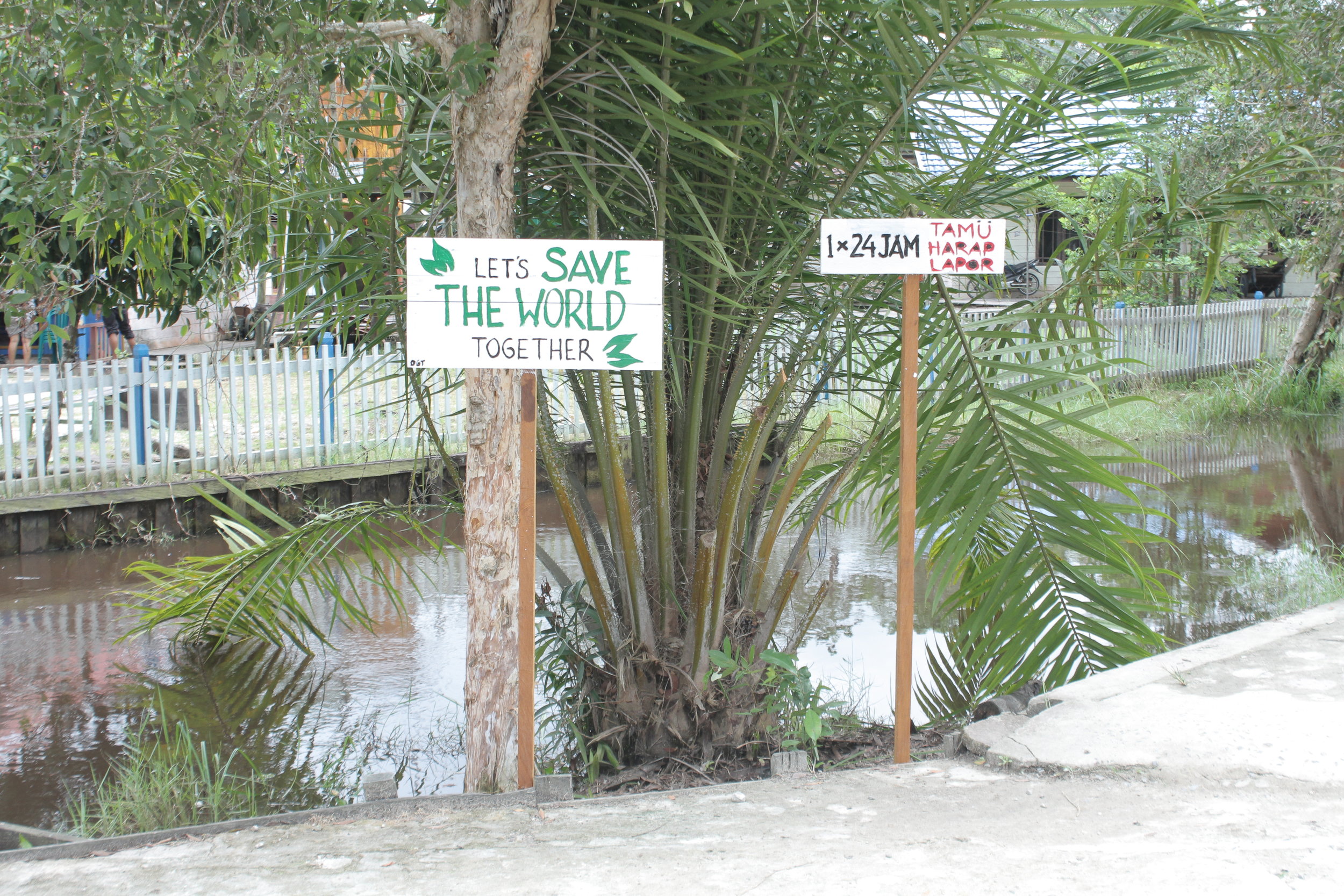

As OF Research Manager Arie reports “We need more…to keep these activities running…support the people of Sekonyer Village! We stand together…”
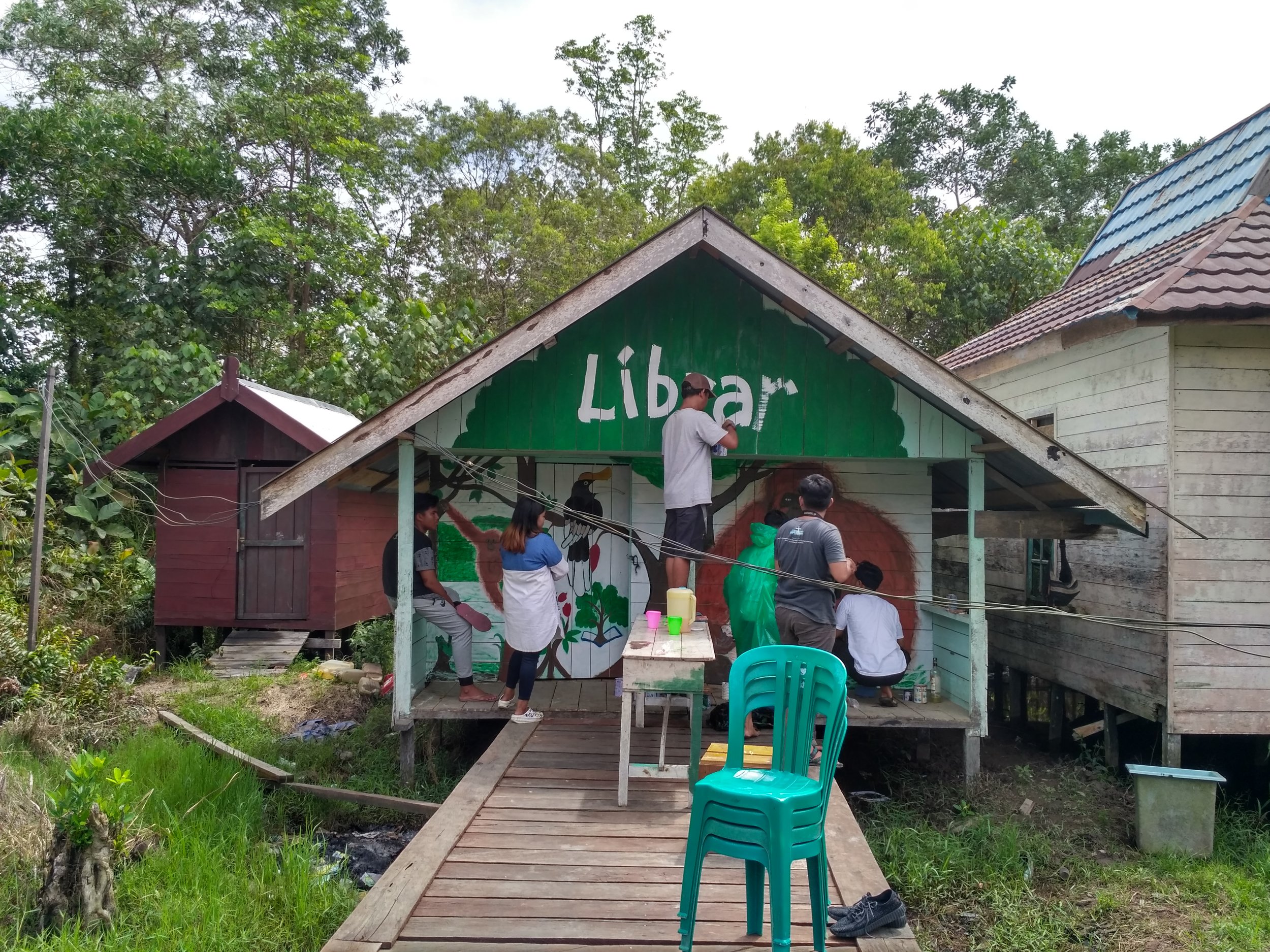
It is vital we reach out to local communities around areas of protected tropical forest habitat in order to ensure a future for orangutans, forests and people.
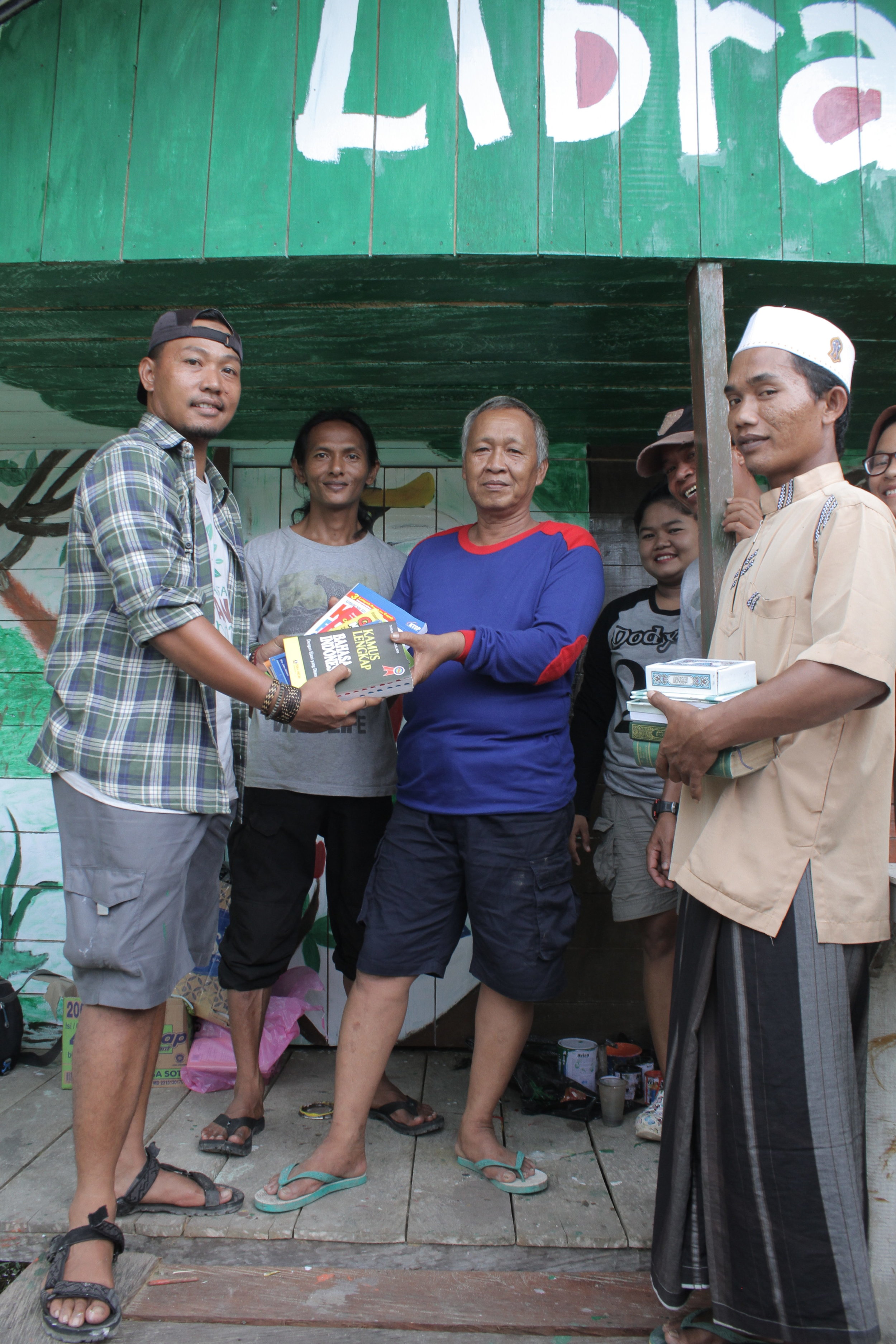
Please donate today to support the Orangutan Foundation’s community work in Central Kalimantan, Indonesian Borneo.
Orangutan, Bumi, Rescued With Bullet Wounds
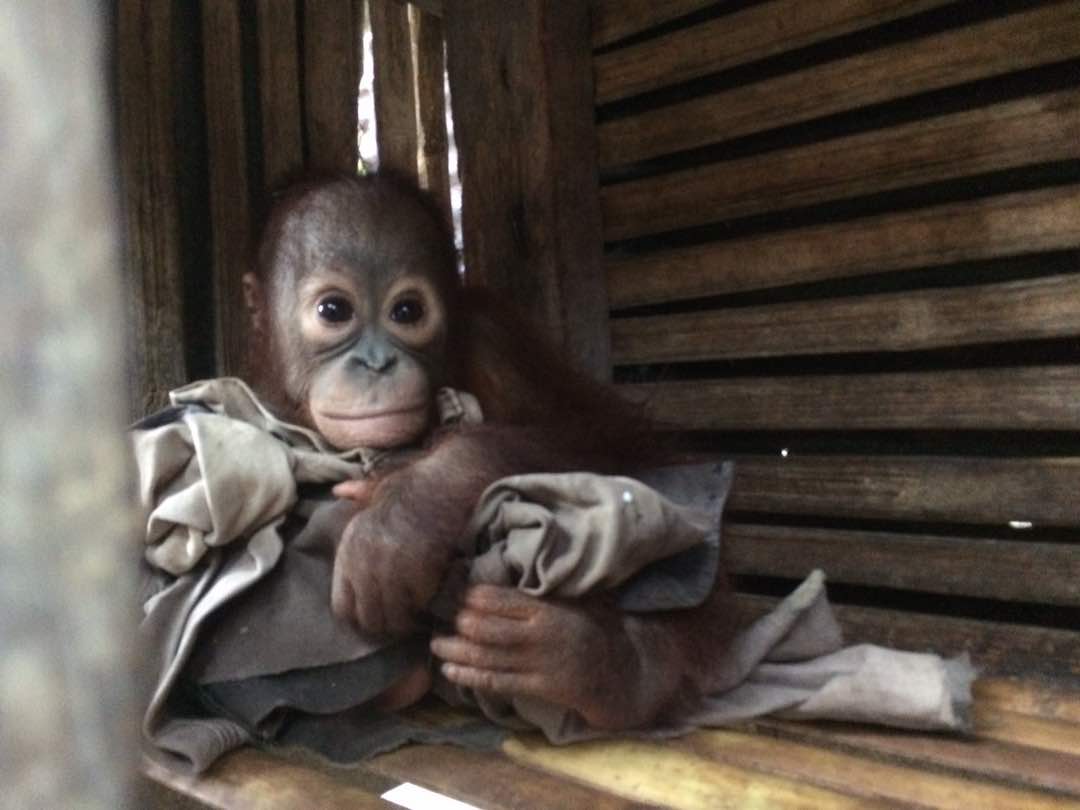 On 19th June 2017, BKSDA informed our field staff that they had just confiscated an orangutan from people who had been keeping it as a pet in a nearby village. This orangutan was entrusted into the care of the Orangutan Foundation.
On 19th June 2017, BKSDA informed our field staff that they had just confiscated an orangutan from people who had been keeping it as a pet in a nearby village. This orangutan was entrusted into the care of the Orangutan Foundation.
The male orangutan was named Bumi (which means Earth in English) and was estimated to be about 3 and a half years old.

Our vet checked Bumi’s health and overall condition, which proved quite difficult as he wouldn’t stay still! He was anesthetized as it was vital that he was looked over thoroughly for any injuries or illness.
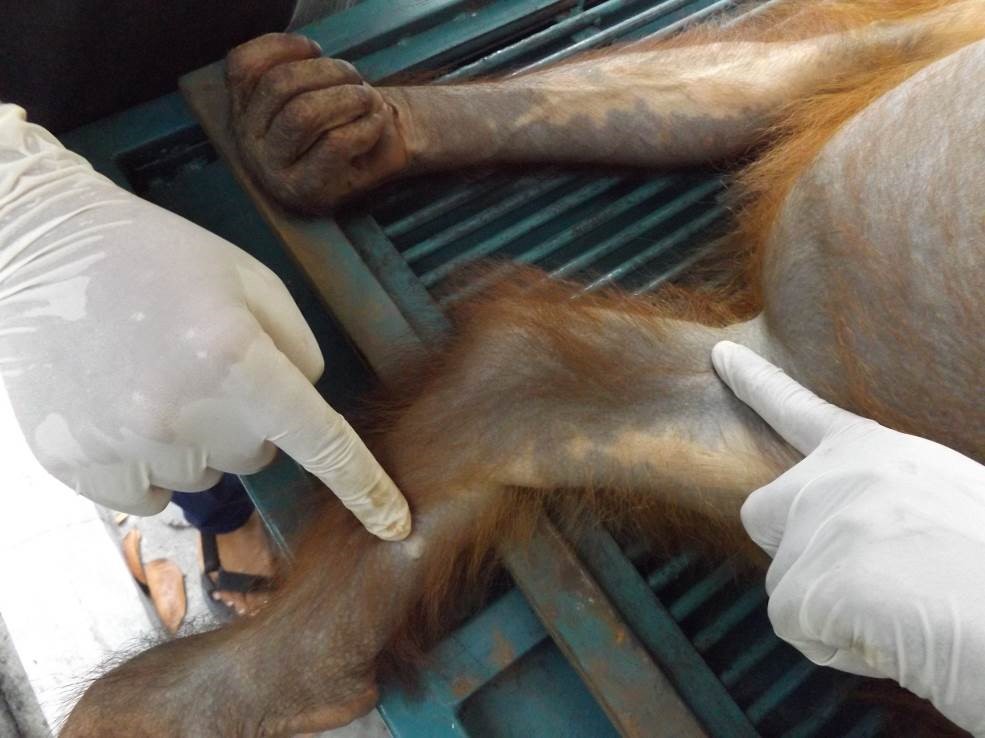
During the assessment, bullets were discovered in Bumi’s body. We are uncertain of the origin of the bullets, but it is likely a result of people attempting to shoot the mother to obtain the infant.
This, tragically, is how most orangutans enter our Soft-Release Programme.

In total, 7 bullets were removed from Bumi’s body. Bumi was given health supplements, and once he’d recovered from the operation, he was ready to join our Soft-Release Programme.
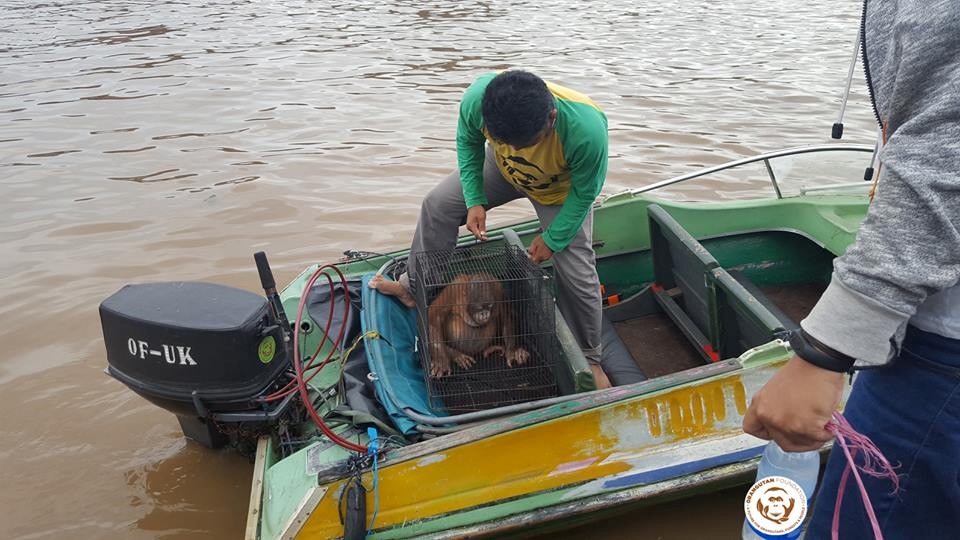
Bumi was taken to Camp Rasak in the Lamandau Wildlife Reserve, Indonesian Borneo. Here he will be cared for alongside Endut, an orangutan of a similar age also rescued from being kept as a pet last March.
Staff report that since settling in Bumi appears to have a good appetite and has already displayed nest-making skills.

Watch this clip to see Bumi showing off his skills:
Please DONATE today to support the progress of Bumi and the other orangutans currently in our Soft-Release Programme.
Orangutan Foundation Welcomes New Arrival
In September 2015, Central Kalimantan was hit by major forest fires. Many orangutans needed rescuing from areas of burning forest and community land.
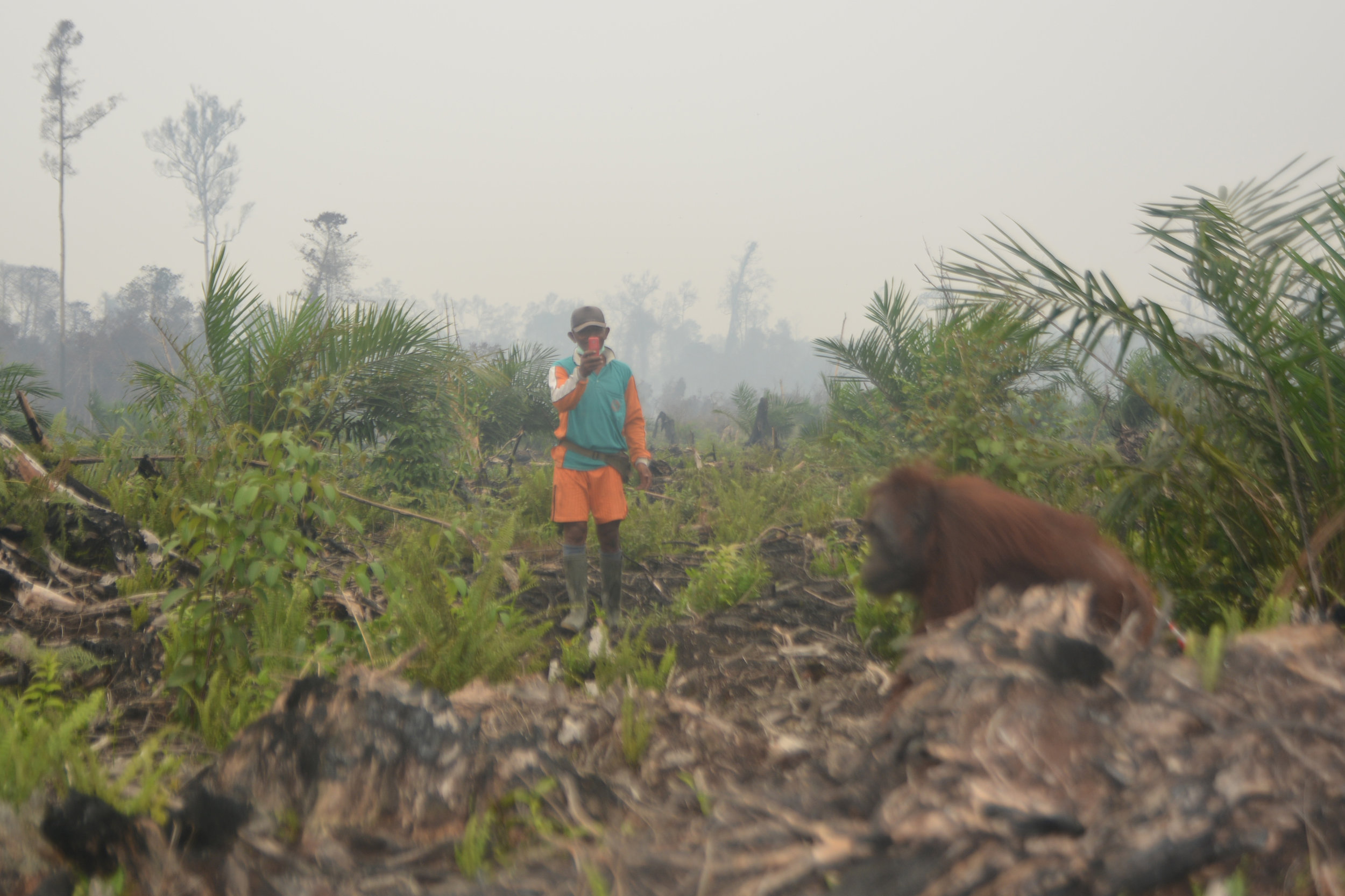
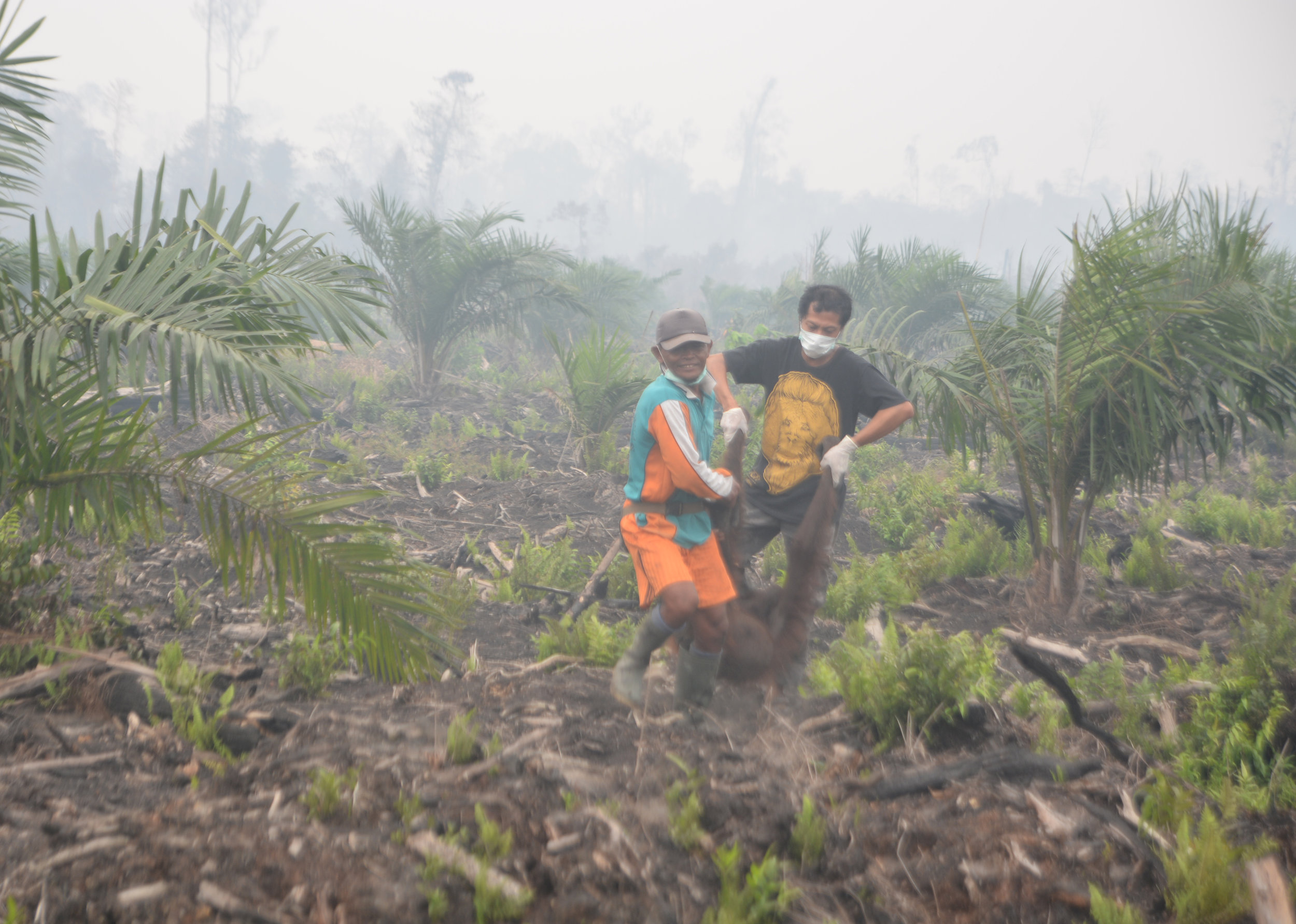
One such orangutan was Vania, a 29 year old female orangutan, named after a student who was doing research on orangutans in the Lamandau Wildlife Reserve at the time. Vania and her 6 year old offspring (named Venty) were rescued from an oil palm plantation and released by Camp Buluh in the Lamandau Wildlife Reserve.

Both are now in good health and are still frequently seen in the area. As shared yesterday, field staff have informed us that Vania gave birth on 25th May to an infant they have named Volvo.
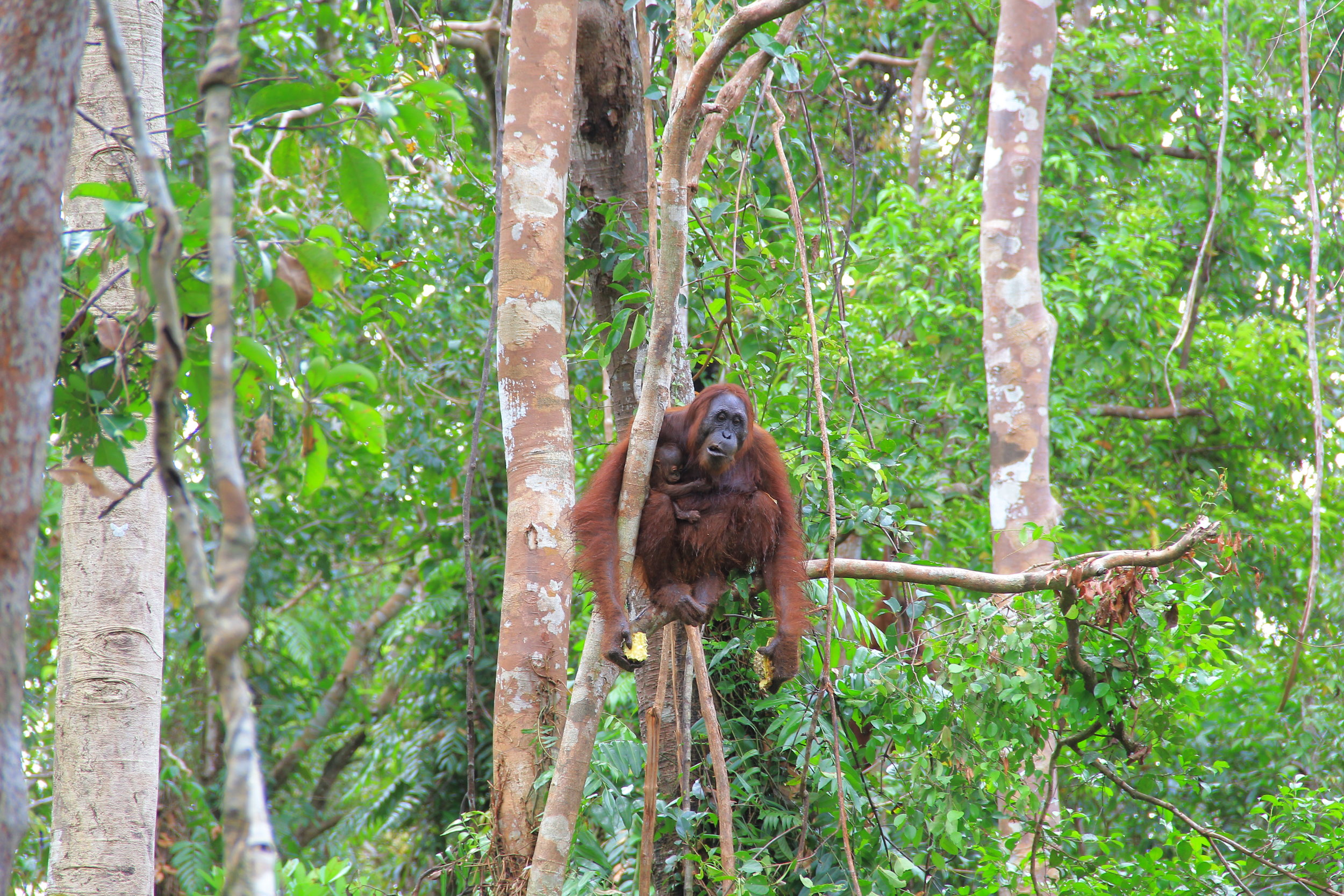
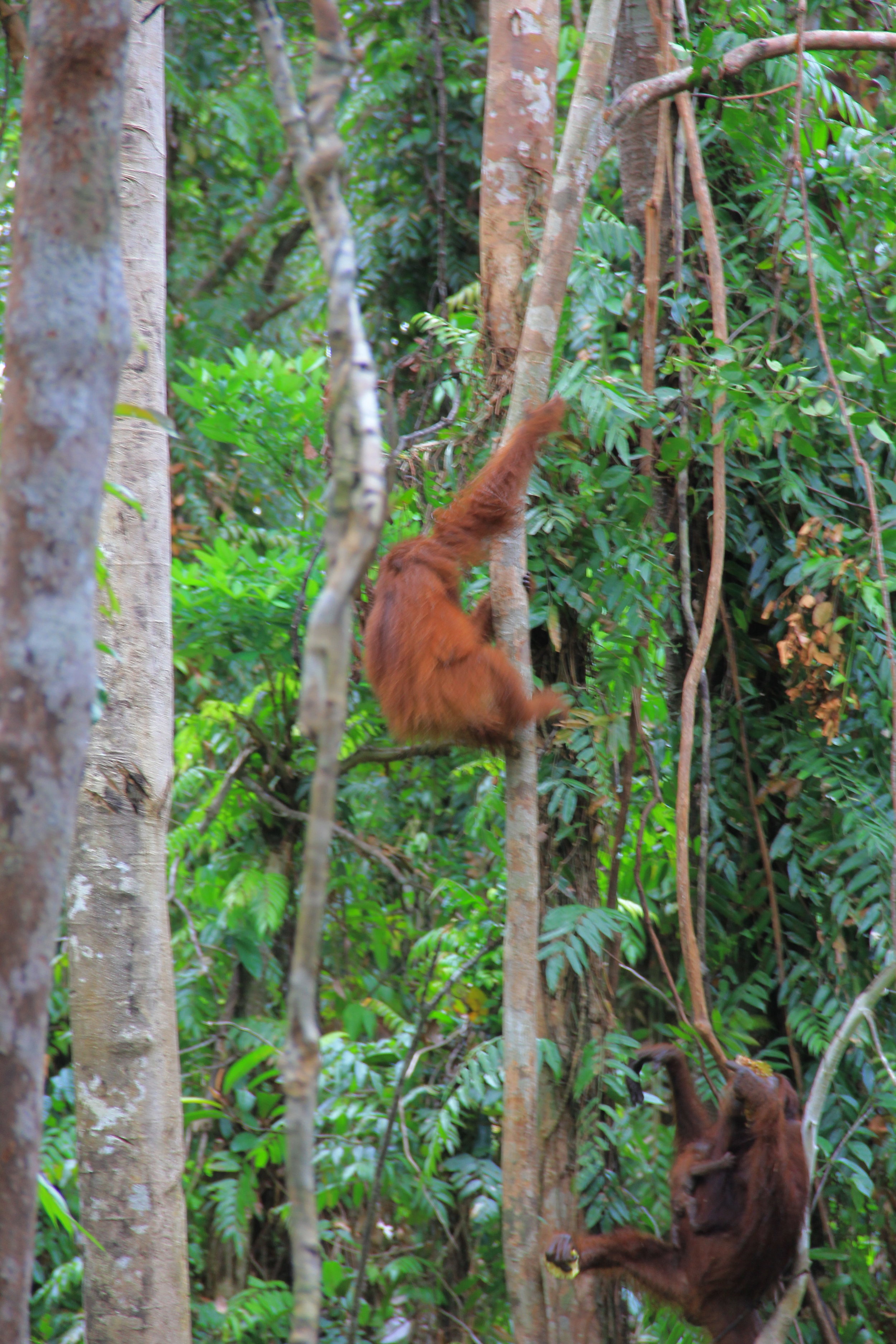
Vania has been seen around camp since the birth to show off her new arrival.
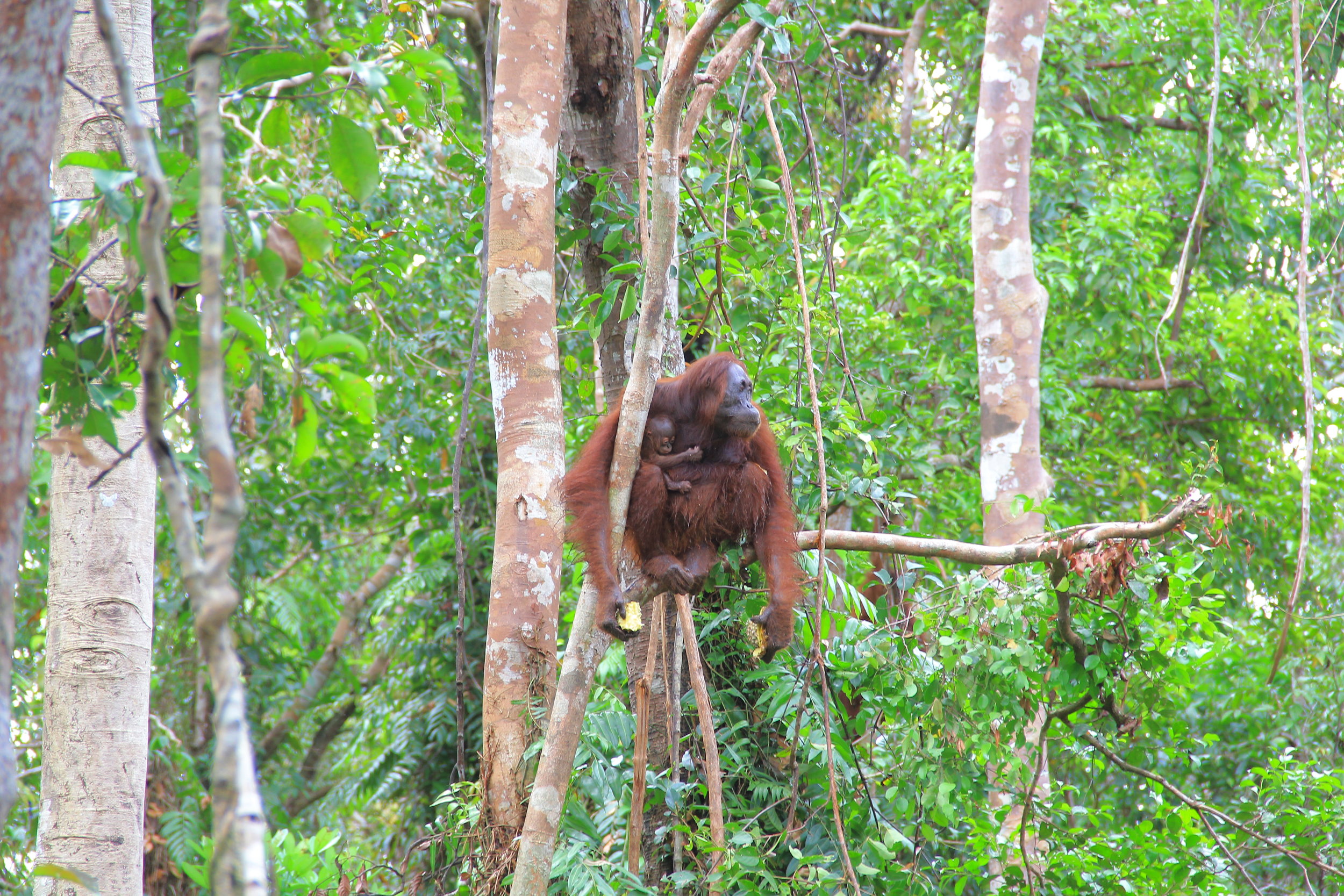
Welcome Volvo to the Lamandau Wildlife Reserve!
Would you like to play an active part in the protection of Volvo's tropical forest home?
Become a guardian of Lamandau and help us ensure a future for orangutans, forests and people. Click here for more information.
The Lamandau Wildlife Reserve
We are delighted to be able to convey the news that two of our soft-release orangutans, Jessica and Ketty, have now been released into the Lamandau Wildlife Reserve. Staff are confident both will go on to living fulfilling lives in the wild, free from the threat of habitat loss.


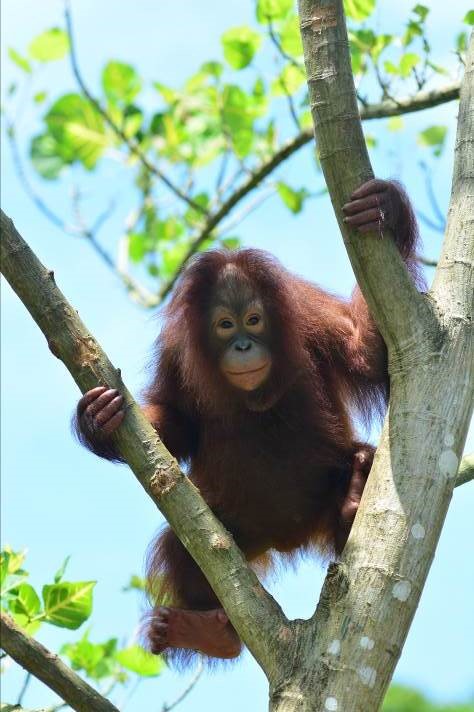
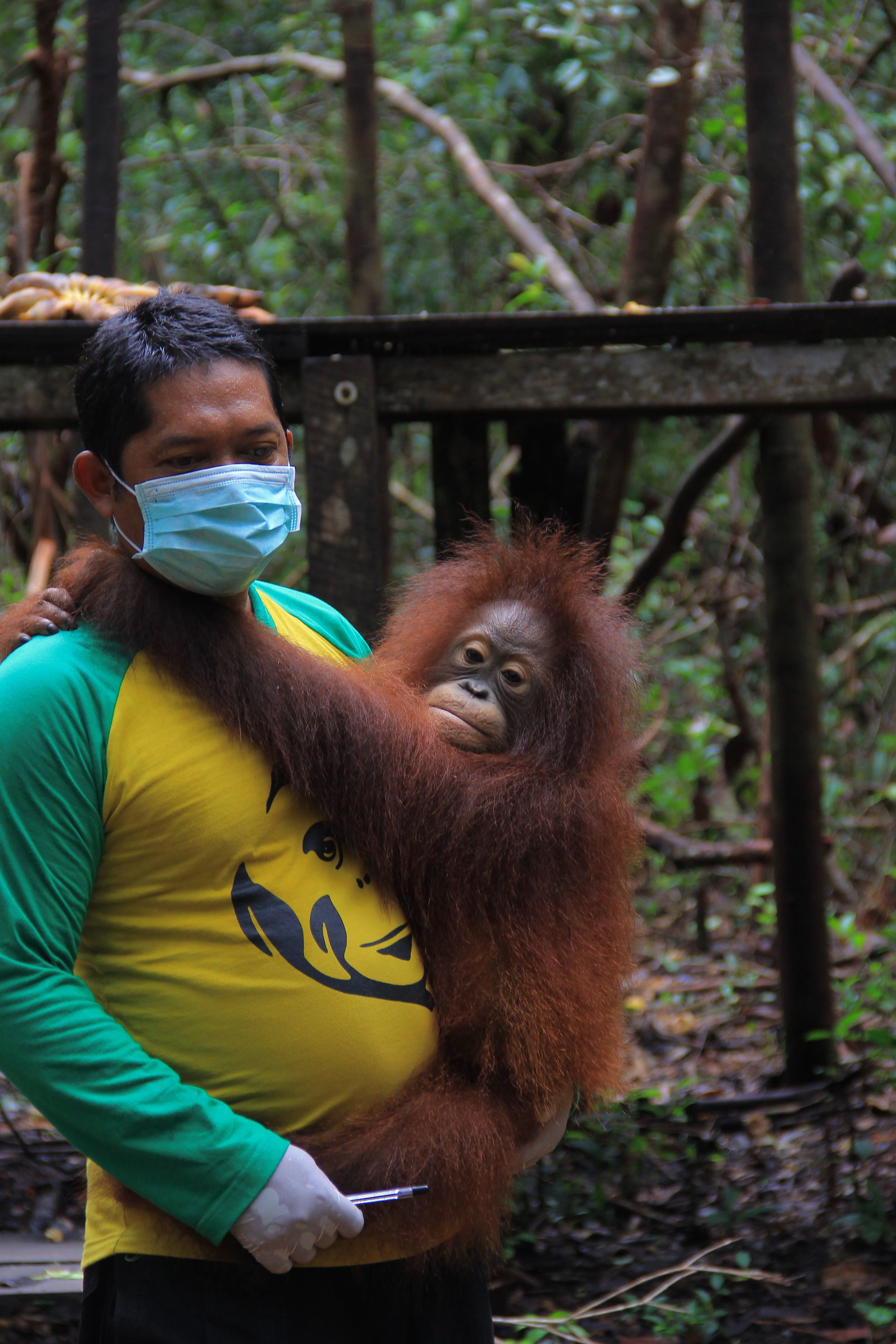
In light of this positive news and #RainforestLive, we are introducing a new initiative in support of the Lamandau Wildlife Reserve.
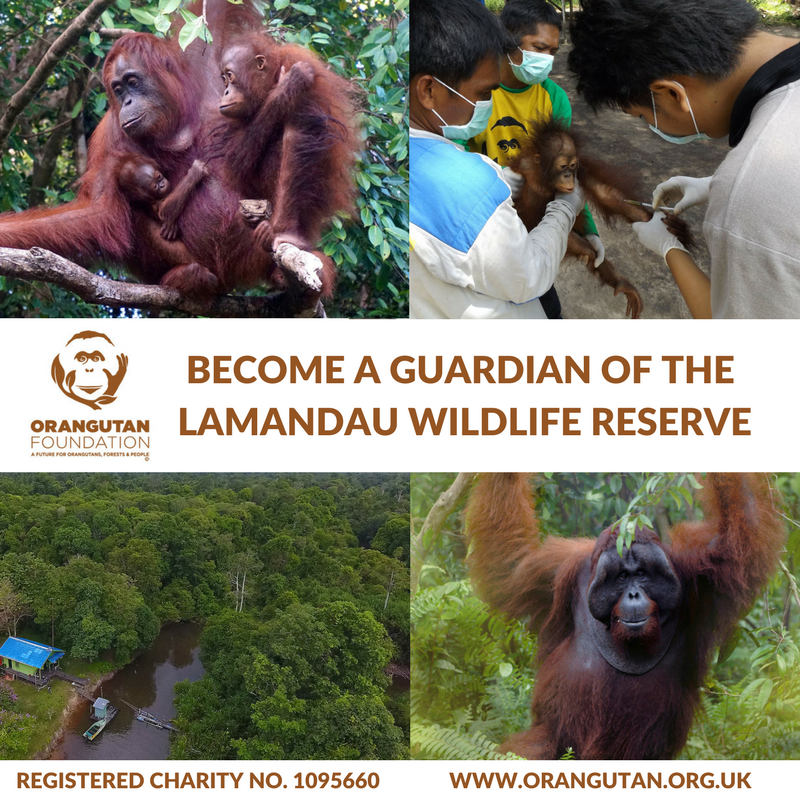
Become a guardian and actively protect:
- 158,144 acres of tropical peat forest in Central Kalimantan, Indonesian Borneo
- 500 critically endangered orangutans - a number which continues to increase as more are rescued and released
- thousands of threatened species including gibbons, sun bears and clouded leopards
- 5 million tonnes of stored carbon.
A regular gift of £16.50 a month or a one-off donation of £200 for the year (the equivalent of 55p a day) will contribute towards the management of the Reserve.
Visit our webpage for more information on how to become a guardian.


